Herons are a group of large wading birds found in many parts of the world. They have long, thin legs and long necks, and they can be seen standing in water or wading through shallows in search of food.
Herons are highly adaptable and can be found in both fresh and saltwater habitats. With around 60 different species, herons come in a variety of shapes, sizes, and colors.
They are an important part of many ecosystems, helping to keep the balance of nature by preying on small fish, frogs, and other aquatic life.
1. Great Blue Heron
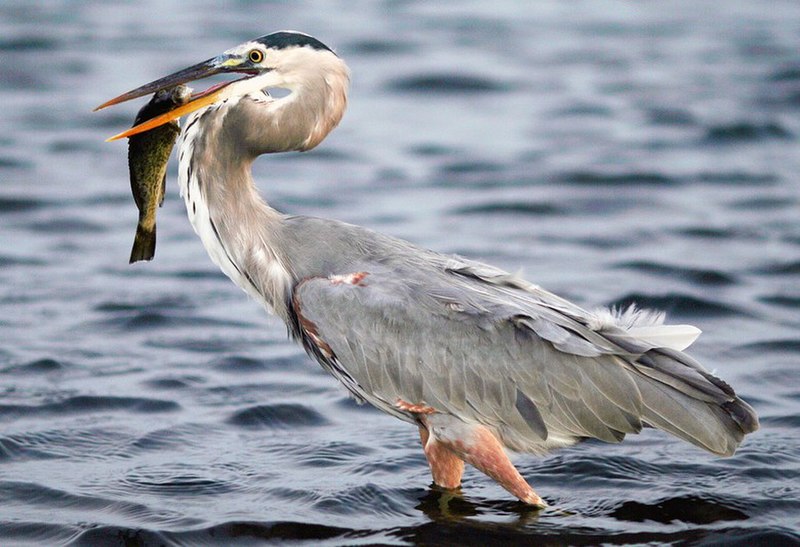
The Great Blue Heron is a majestic wading bird found in many parts of North America, Central America, the Caribbean, and even as far away as the Galapagos Islands.
It has an impressive wingspan which can reach up to six feet wide. Its feathers are mainly bluish-gray with brownish streaks on both its neck and chest while its head displays white plumes.
The adult herons can also be identified by their yellow bill and legs.
They live near bodies of water such as lakes, marshes, or rivers where they feed on fish using a spear-like motion with their sharp bills.
An all-white population exists only in South Florida and the Florida Keys making it unique.
Scientific classification:
| Kingdom | Animalia |
| Phylum | Chordata |
| Class | Aves |
| Order | Pelecaniformes |
| Family | Ardeidae |
| Genus | Ardea |
| Species | A. herodias |
2. Great Egret
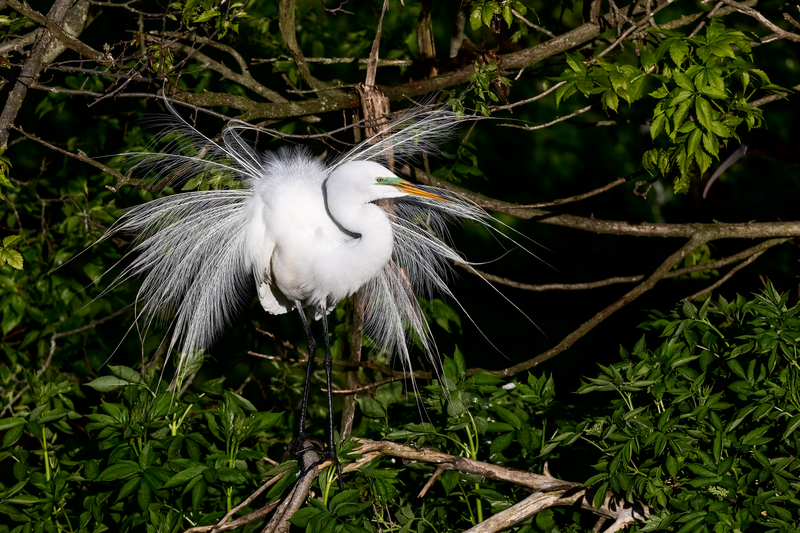
The Great Egret is a large, white bird found in many regions of the world. It has four subspecies that reside across Asia, Africa, the Americas, and southern Europe.
This species usually lives near bodies of water such as lakes and marshes. They are also now starting to spread into more northern areas of Europe due to climate change.
These birds have long yellow legs with an impressive wingspan for their size which allows them to soar majestically through the sky hunting for fish or amphibians in shallow waters below.
Their feathers have been used historically by Native Americans as part of traditional garments or ceremonies but this practice should be avoided today so these amazing creatures can thrive without harm from humans.
Scientific classification:
| Kingdom | Animalia |
| Phylum | Chordata |
| Class | Aves |
| Order | Pelecaniformes |
| Family | Ardeidae |
| Genus | Ardea |
| Species | A. alba |
3. Grey Heron
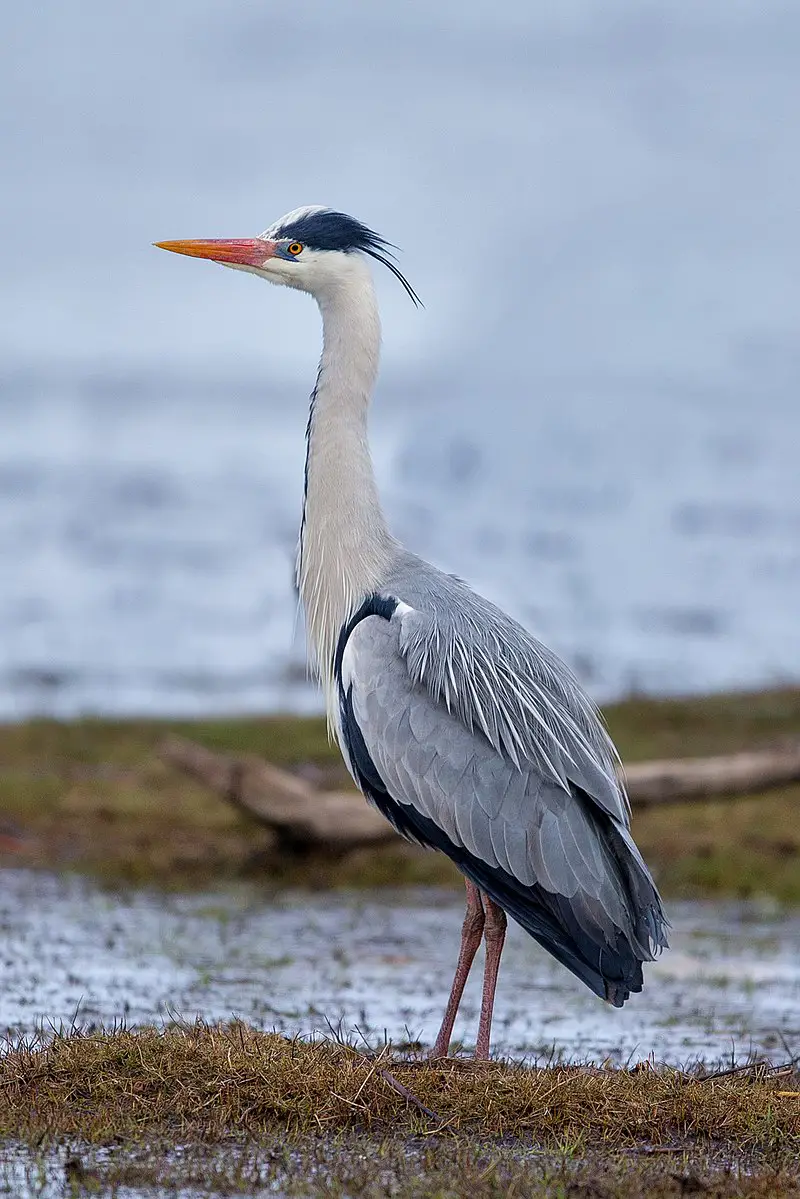
The grey heron is a majestic bird found in temperate regions of Europe, Asia, and parts of Africa. It has long legs to wade through the shallow waters where it feeds on aquatic creatures such as frogs, fish, and insects.
In wintertime, some migrate southwards but others stay put in their natural habitats; lakes, rivers, and marshes. They can also be spotted near coasts or along estuaries.
Grey Herons have beautiful blue-grey feathers and an impressive wingspan that makes them stand out from other birds when they soar gracefully across the sky.
These graceful creatures are not only easy on the eye but wise hunters too.
Scientific classification:
| Kingdom | Animalia |
| Phylum | Chordata |
| Class | Aves |
| Order | Pelecaniformes |
| Family | Ardeidae |
| Genus | Ardea |
| Species | A. cinerea |
4. Black-Crowned Night Heron
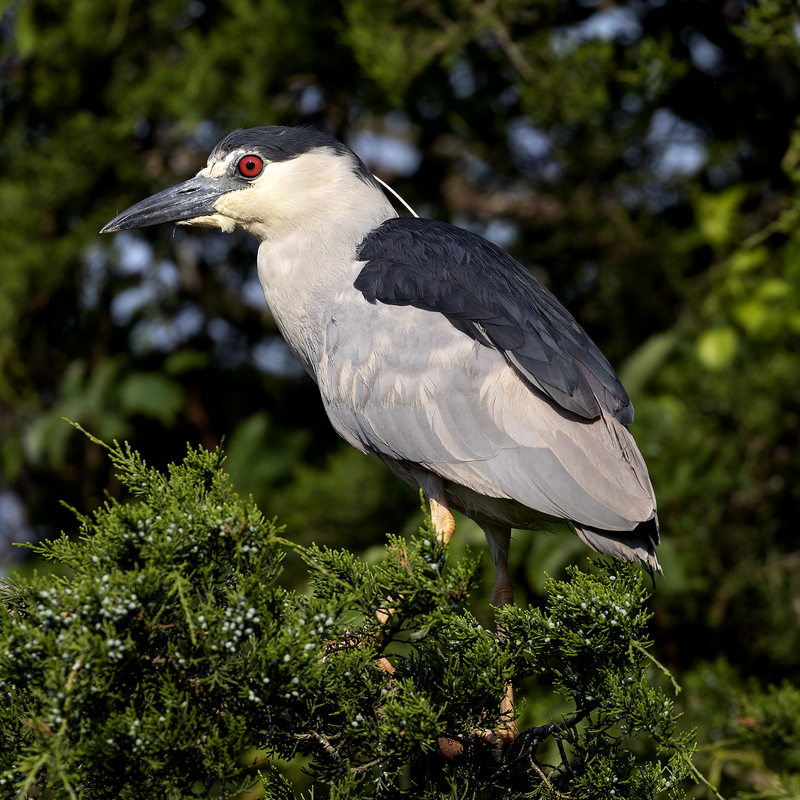
The Black-crowned night heron (Nycticorax nycticorax) is a medium-sized bird found in various parts of the world, including Europe, Asia, and North and South America.
It has black crowns on its head with white feathers underneath. Its wings are greyish brown while its underparts are mostly white.
This species can be seen foraging near shallow water or along coastlines during dusk or dawn as it hunts small fish, amphibians, and crustaceans.
They also feed on insects such as grasshoppers and beetles which they find in meadows close to freshwater bodies like lakes or ponds where they breed during springtime making nests using twigs lined with reeds and leaves near these waterside habitats.
In Australasia, this species hybridizes with the nankeen night heron that inhabits those areas instead; however, both populations remain distinct from each other despite their overlapping range regions.
Scientific classification:
| Kingdom | Animalia |
| Phylum | Chordata |
| Class | Aves |
| Order | Pelecaniformes |
| Family | Ardeidae |
| Genus | Nycticorax |
| Species | N. nycticorax |
5. Green Heron
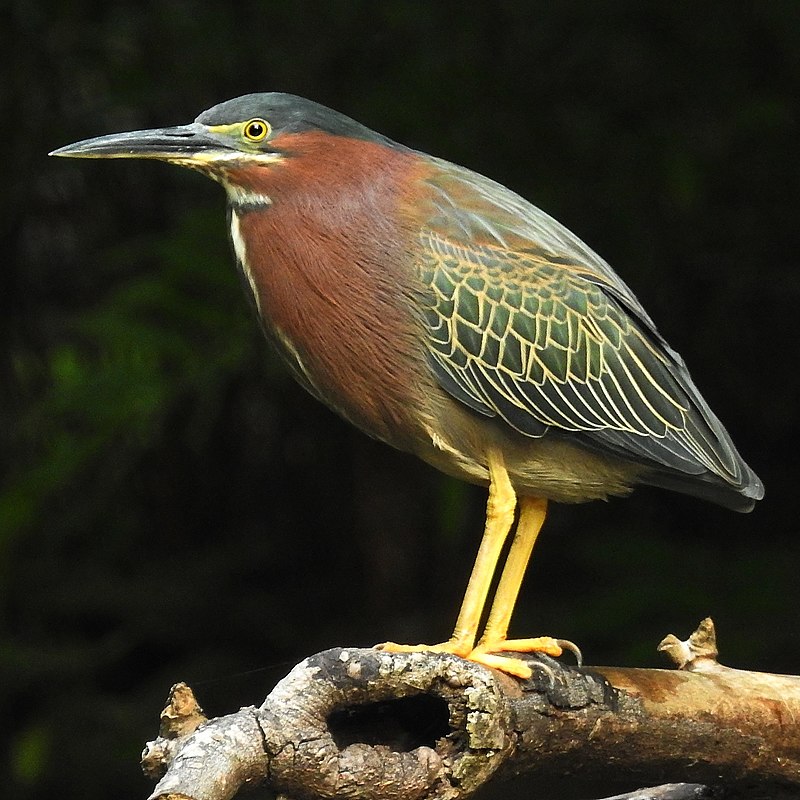
The Green Heron (Butorides virescens) is a small heron found throughout North and Central America.
Its scientific name comes from the Middle English ‘butor’ meaning bittern, combined with the Latin term for its distinctive greenish color – ‘virescens’.
For many years it was considered to be part of the same species as the Striated Heron (Butorides striata), commonly referred to as “green-backed herons”.
The nominate subspecies inhabits wetlands across much of this range, where they can be spotted stalking about in shallow water looking for fish or frogs on which to feed.
They are fascinating wading birds that have even been known to use tools such as sticks or baited lines when fishing.
Scientific classification:
| Kingdom | Animalia |
| Phylum | Chordata |
| Class | Aves |
| Order | Pelecaniformes |
| Family | Ardeidae |
| Genus | Butorides |
| Species | B. virescens |
6. Little Blue Heron
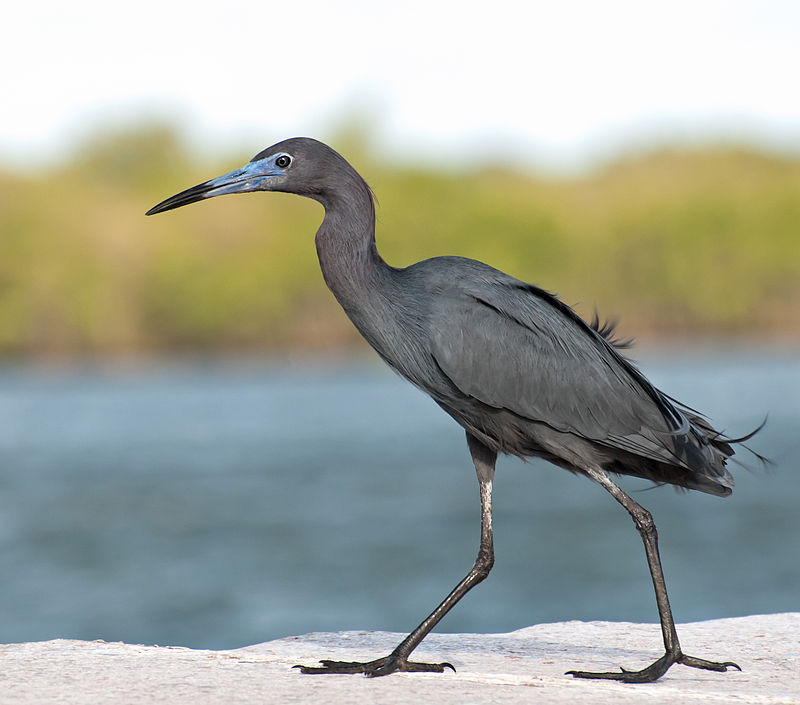
The Little Blue Heron is a small, darkly-colored heron with two-toned bill. Juveniles are completely white, similar to the Snowy Egret. In breeding season, adults develop unique coloration on their heads and legs.
The bird has an expansive habitat range that covers much of the Americas from North America down to South America.
They feed mostly in shallow water areas like tidal flats or marshes and eat small aquatic animals such as fish, frogs, and crustaceans.
This species can also be found along coastal regions where they gather at night for roosting purposes during winter months when food sources become more scarce due to the migration patterns of its prey animals.
These birds have adapted well over time allowing them to persist in most habitats throughout their wide range even despite environmental changes caused by human activities such as pollution or development projects near wetlands ecosystems which are essential for this species’ survival.
Scientific classification:
| Kingdom | Animalia |
| Phylum | Chordata |
| Class | Aves |
| Order | Pelecaniformes |
| Family | Ardeidae |
| Genus | Egretta |
| Species | E. caerulea |
7. Snowy Egret
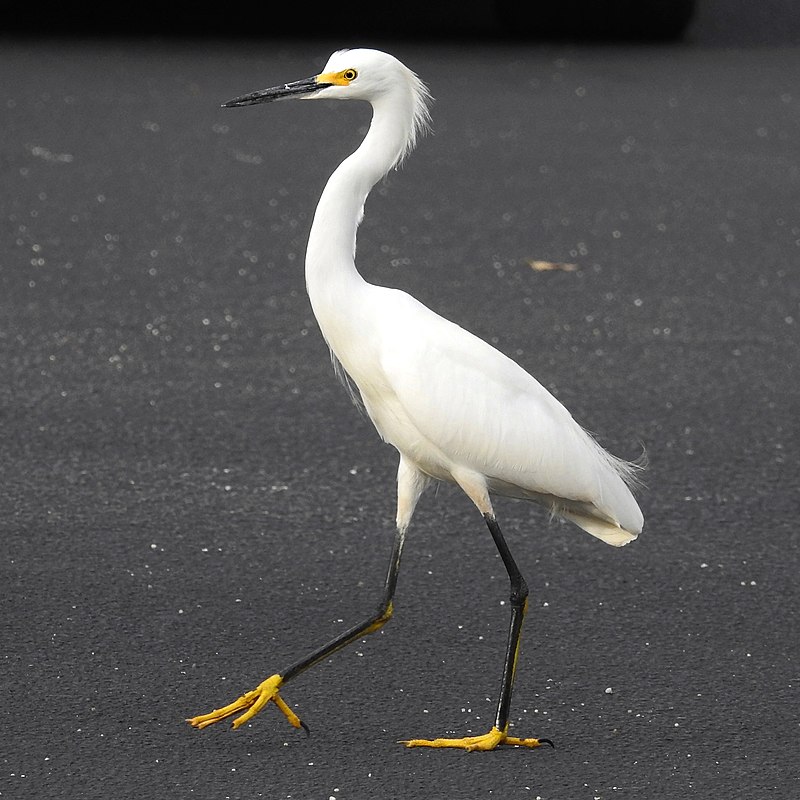
The Snowy Egret is a small white heron native to North America. Its scientific name, Egretta thula, comes from Provençal French for the little egret and an incorrect reference to the Black-necked Swan by Chilean naturalist Juan Ignacio Molina in 1782.
This beautiful bird has black legs yellow feet, and a long plume of feathers on its head that often appears as if it’s wearing a crown.
It feeds primarily on insects and aquatic life like fish or frogs making it well adapted for both wetland habitats such as marshes or swamps plus coastal areas close to shorelines.
With their graceful movements, they are truly delightful creatures to observe while out exploring nature.
Scientific classification:
| Kingdom | Animalia |
| Phylum | Chordata |
| Class | Aves |
| Order | Pelecaniformes |
| Family | Ardeidae |
| Genus | Egretta |
| Species | E. thula |
8. Yellow-Crowned Night Heron
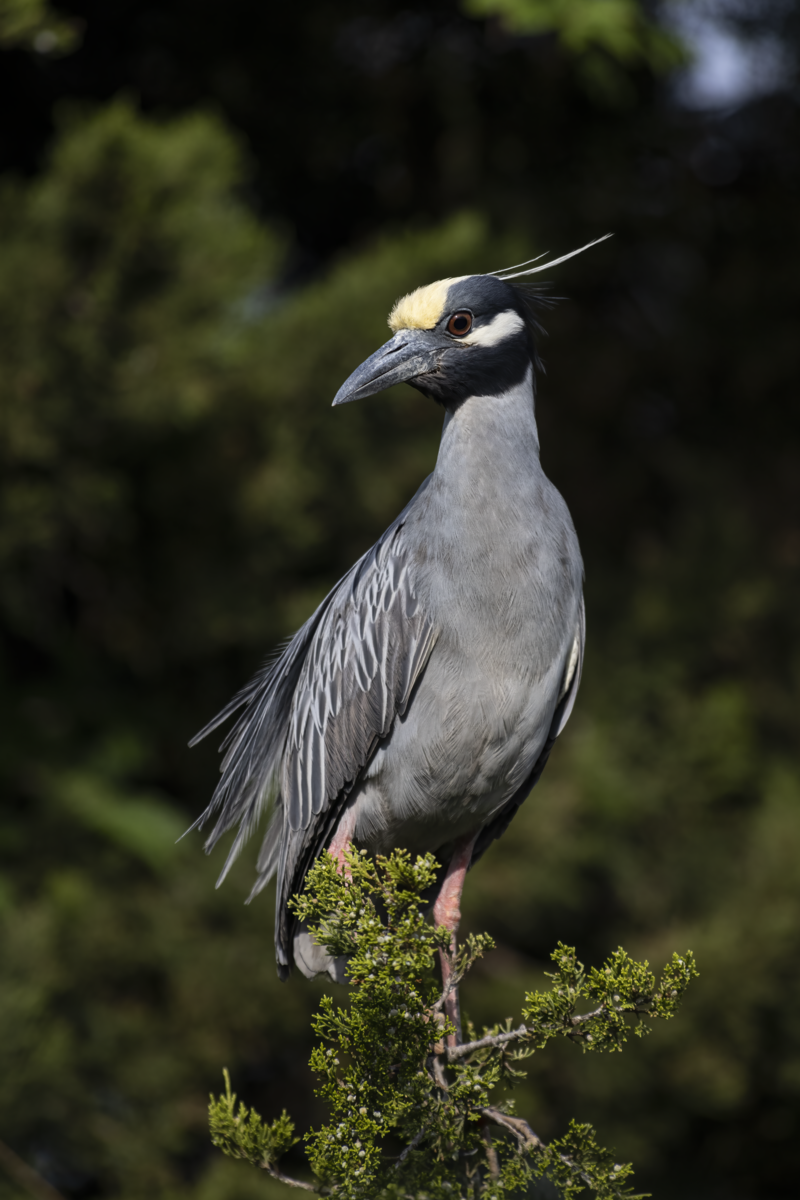
The Yellow-crowned night heron is a beautiful and unique species of bird native to the Americas. It has distinctive yellow crowns on its head, making it easy to identify among other herons.
These birds are also larger than most other types of herons, reaching up to 70 cm in length and 850 g in weight.
They usually feed on small fish or crustaceans while wading through shallow waters with their long legs.
The yellow-crowned night heron can be found near marshes or lakes during breeding season when they will build nests made from twigs high above the ground for protection against predators like raccoons and foxes.
This majestic bird is an important part of wetland ecosystems as it helps keep populations of smaller aquatic animals balanced by preying upon them.
Scientific classification:
| Kingdom | Animalia |
| Phylum | Chordata |
| Class | Aves |
| Order | Pelecaniformes |
| Family | Ardeidae |
| Genus | Nyctanassa |
| Species | N. violacea |
9. Cattle Egret
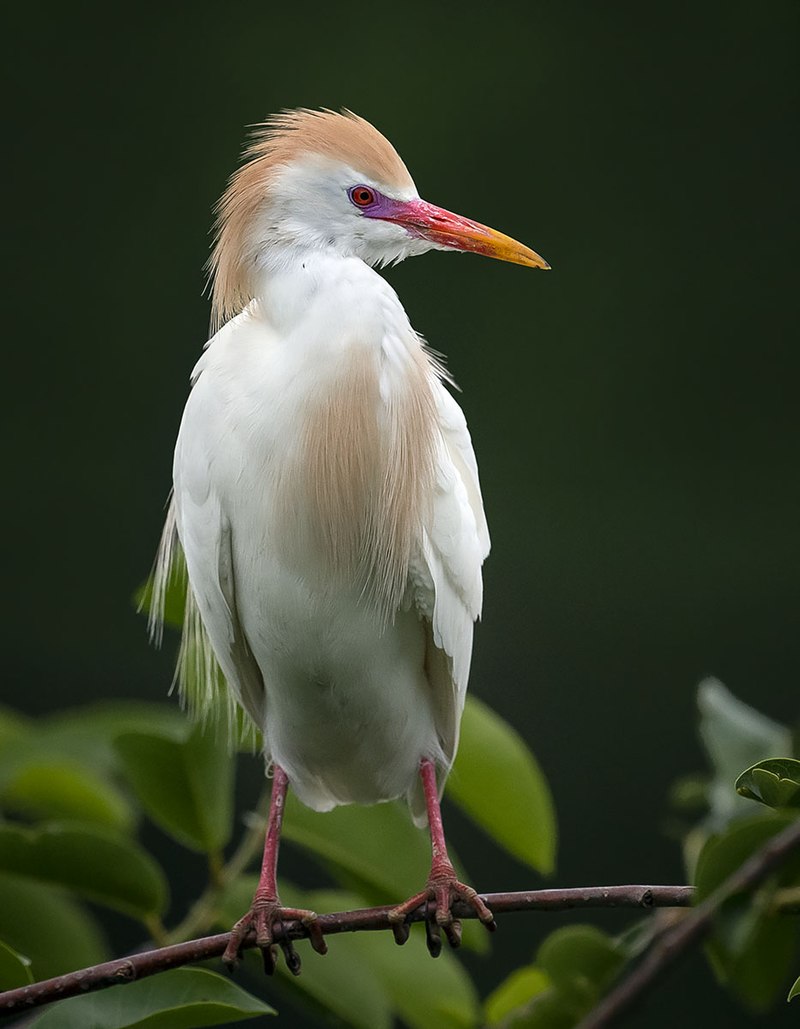
The Cattle Egret is a heron of the family Ardeidae found around the world in tropical, subtropical, and warm temperate areas. It has two subspecies: western cattle egret and eastern cattle egret.
They have white plumage with buff plumes on their head, neck, and back. The beak is yellowish-orange with a black tip while the legs are orange or yellow coloured depending on species variation.
This bird usually feeds near large herds of animals such as cows, horses, etc., where it finds plenty of insects to eat like grasshoppers, crickets, etc.
Its presence benefits these animals by removing ectoparasites from them which leads to a healthier livestock population.
It nests colonially in trees or shrubs located close to water bodies during breeding season which generally takes place between March and June every year.
Scientific classification:
| Kingdom | Animalia |
| Phylum | Chordata |
| Class | Aves |
| Order | Pelecaniformes |
| Family | Ardeidae |
| Genus | Bubulcus Bonaparte, 1855 |
| Species | B. ibis |
10. American Bittern
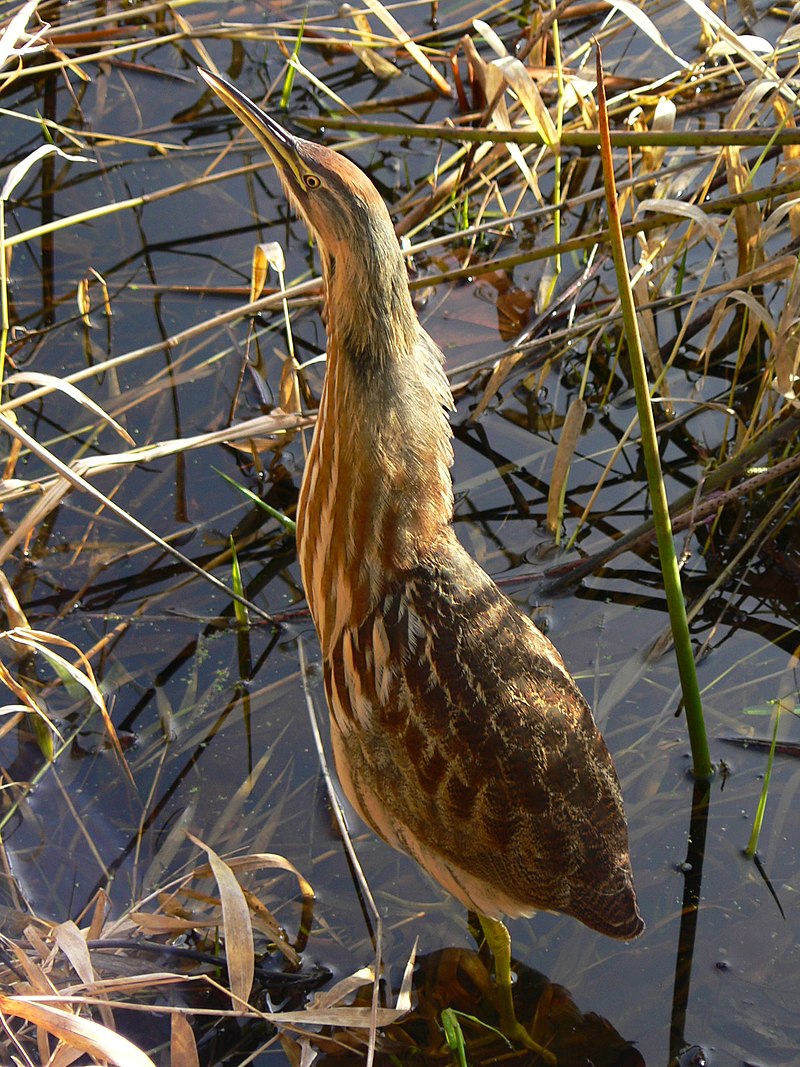
The American Bittern is a solitary, brown-wading bird from the heron family. It lives in North America and Central America, breeding in Canada and northern parts of the United States before migrating south to winter on the states surrounding the Gulf Coast as well as Florida’s Everglades.
Not only does it blend into its surroundings thanks to its muted coloring but it also has a unique call that helps keep it hidden – an “un-ducklike” booming sound that can travel long distances due to low-frequency vibrations.
The bittern spends most of their time alone but during mating season they become more social while gathering together at wetlands for courtship activities such as displaying feathers erect or head bobbing.
Scientific classification:
| Kingdom | Animalia |
| Phylum | Chordata |
| Class | Aves |
| Order | Pelecaniformes |
| Family | Ardeidae |
| Genus | Botaurus |
| Species | B. lentiginosus |
Also Featured In: Birds That Live in Colorado, New Hampshire Birds You Should Know
11. Tricolored Heron
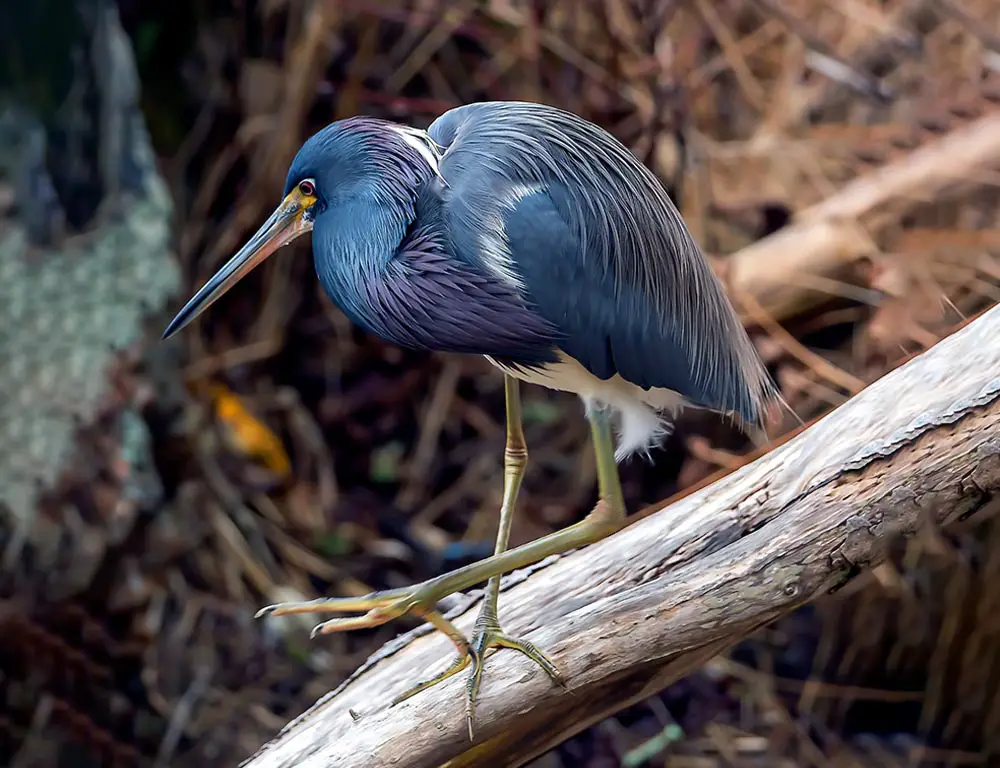
The Tricolored heron is a stunning species of wading bird found in South America, Central America, and the Caribbean. It has an impressive wingspan of 33-37 inches, with its back being dark blue or grey and its chest and belly whitish.
Its neck shows off beautiful streaks of purple, blue, or white colors which give it the name ‘tricolored’. They inhabit marshlands close to bodies of water such as lakes and rivers.
This heron eats mainly small fish but also crustaceans, amphibians, and insects that they catch while slowly stalking through shallow waters using their long legs.
In addition to searching for food during daylight hours, they also hunt at night when most other birds sleep soundly.
The tricolored heron can be seen perched atop tall trees overhanging waterways where it scans the area below before plunging into deeper pools to feed on unsuspecting prey.
Their nests are built up high in palmettos or mangroves near wetlands making them difficult to spot at times.
12. Black Heron
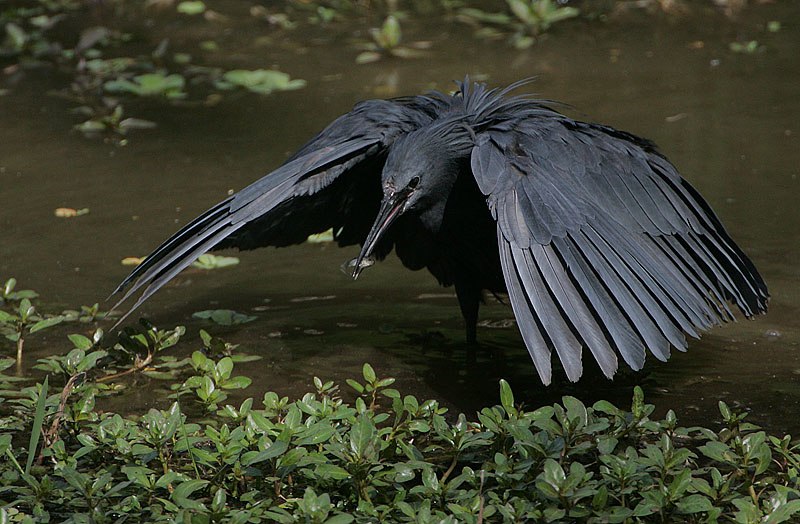
The Black heron is a majestic bird found mainly in Africa. It stands at an average height of 42.5-66 cm and has black plumage with a yellow beak, lores, and feet.
During breeding season it grows long plumes on its crown giving it an exquisite appearance; this is also the time when their wings form a canopy while they fish which makes them easily recognizable from other birds.
Seeing as they occur patchily throughout sub-Saharan Africa, South Asia, and Madagascar, there are various conservation efforts to protect this species from extinction due to habitat destruction or illegal hunting for feathers/meat.
Scientific classification:
| Kingdom | Animalia |
| Phylum | Chordata |
| Class | Aves |
| Order | Pelecaniformes |
| Family | Ardeidae |
| Genus | Egretta |
| Species | E. ardesiaca |
13. Least Bittern
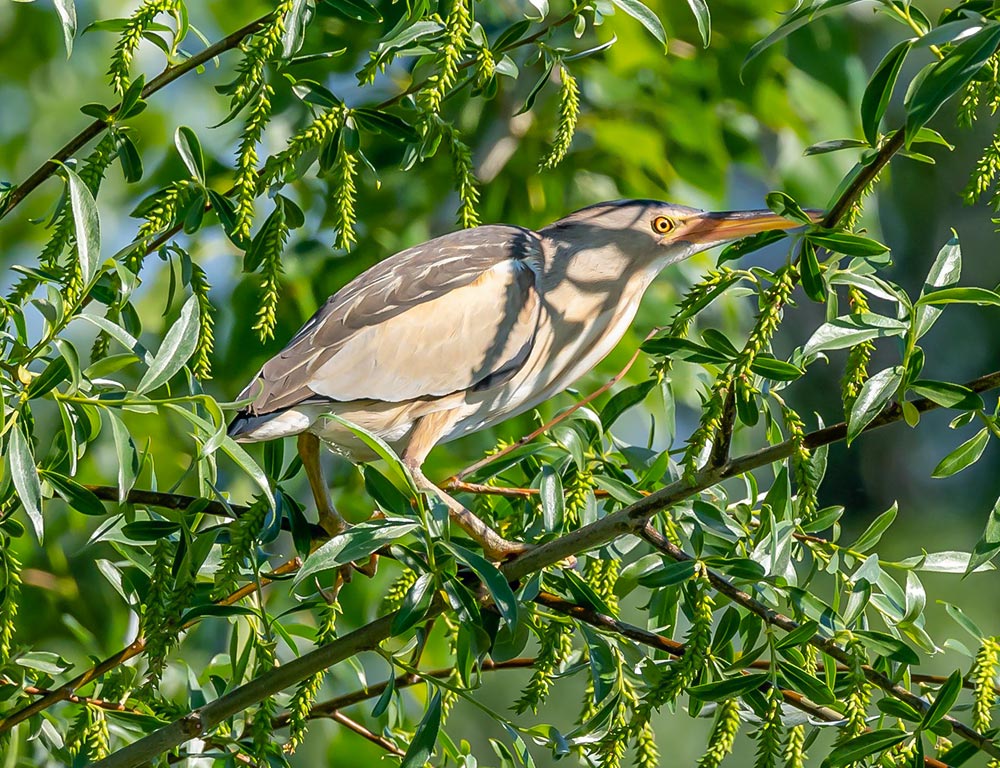
The Least Bittern is a small heron, the smallest of its family Ardeidae. It was first described by German naturalist Johann Friedrich Gmelin in 1789 placed it with other herons, cranes, storks, and bitterns into the genus Ardea.
It can be found across much of North America to Central America as well as South American countries like Argentina, Uruguay, and Brazil.
Its plumage varies from yellowish brown above to white below. The wings are short but pointed allowing for agile flight even over dense vegetation or water bodies where they migrate during breeding season.
They feed on fish, amphibians insects, crustaceans, etc which makes them great hunters near shallow waters or marshes.
Least bitterns build their nests within reeds making them hard to spot while protecting them against predators at the same time providing safety for their eggs & young ones.
Scientific classification:
| Kingdom | Animalia |
| Phylum | Chordata |
| Class | Aves |
| Order | Pelecaniformes |
| Family | Ardeidae |
| Genus | Ixobrychus |
| Species | I. exilis |
14. Striated Heron
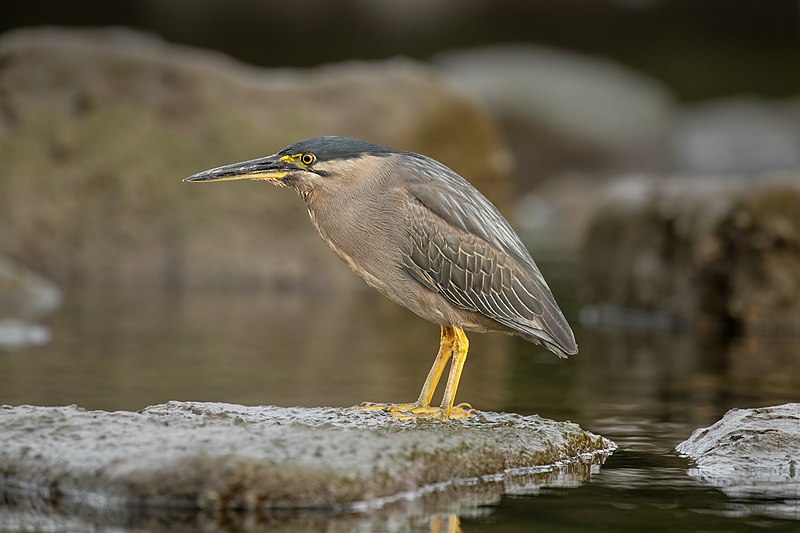
Striated herons are a small species of heron, measuring around 44cm tall. They can be found in wetland areas across the Old World tropics, from West Africa to Japan and Australia as well as South America and the Caribbean.
Striated herons have some interesting behavioral traits that make them unique; they’re mostly sedentary birds who tend to stay close to their breeding habitats throughout most of the year.
During breeding season these little green-backed herons become more active, often performing courtship dances to attract mates before nesting together on nearby trees or shrubs.
Scientific classification:
| Kingdom | Animalia |
| Phylum | Chordata |
| Class | Aves |
| Order | Pelecaniformes |
| Family | Ardeidae |
| Genus | Butorides |
| Species | B. striata |
15. Reddish Egret
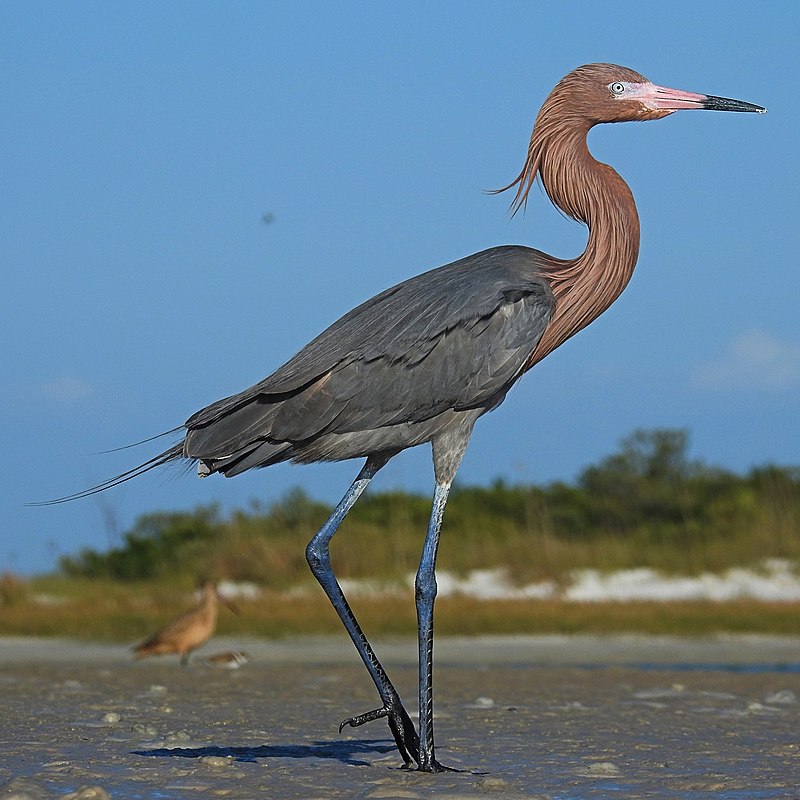
The Reddish Egret is a medium-sized heron that breeds in Central America, The Bahamas, the Caribbean, Texas, and Mexico.
It prefers mud flats as its habitat of choice due to its unique foraging behavior which differs from other herons.
In the past, it was hunted widely for its feathers used to make fashionable hats but thankfully this practice has now been stopped.
They have white or grey plumage with pink legs and bill giving them their name.
These birds feed mainly on fish which they catch by making quick darting movements in shallow water or running rapidly through shallows stirring up prey so they can snatch them easily with their bills.
Their long wings enable them to fly quickly when hunting and also during migration season when many travel southwards towards warmer climates.
Scientific classification:
| Kingdom | Animalia |
| Phylum | Chordata |
| Class | Aves |
| Order | Pelecaniformes |
| Family | Ardeidae |
| Genus | Egretta |
| Species | E. rufescens |
16. Little Egret
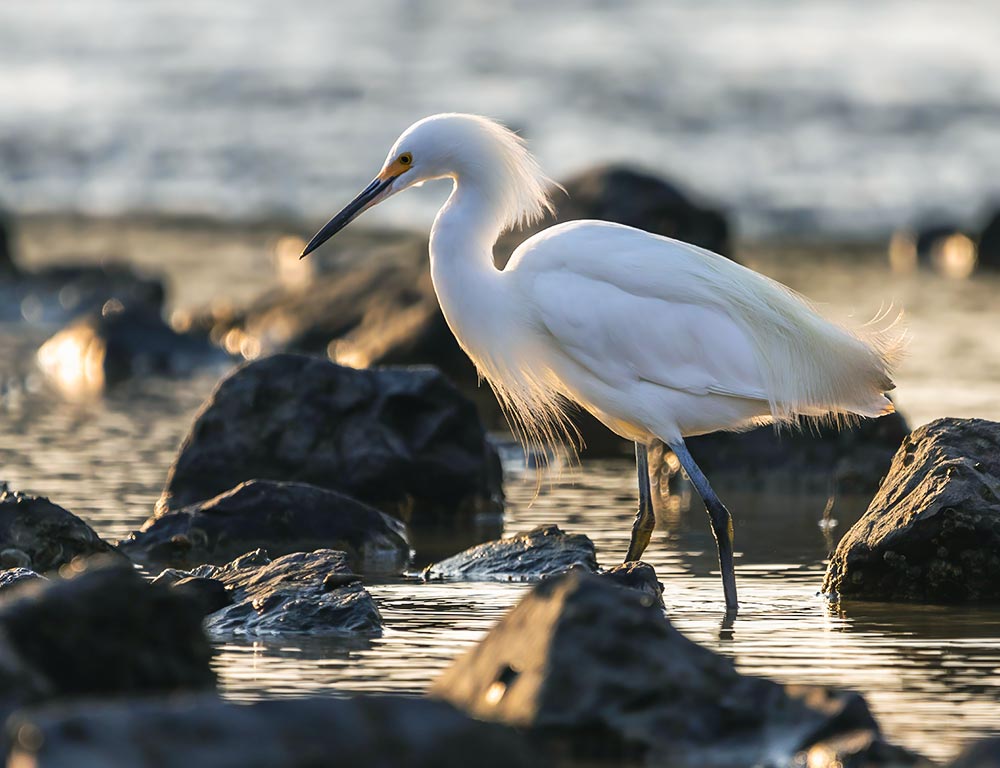
The Little Egret is a small white heron with a sleek black beak, long black legs, and in some cases yellow feet.
It can be found near aquatic areas where it feeds on mollusks, amphibians, and insects while also occasionally feeding on land creatures such as lizards or rodents.
Breeding seasonally they make platform nests of sticks being built either by themselves or in colonies alongside other water birds.
They are widely distributed across the world from Europe to Africa, Asia to Australia making them an easily recognizable bird species often seen at waterside locations searching for their next meal.
Scientific classification:
| Kingdom | Animalia |
| Phylum | Chordata |
| Class | Aves |
| Order | Pelecaniformes |
| Family | Ardeidae |
| Genus | Egretta |
| Species | E. garzetta |
17. Purple Heron
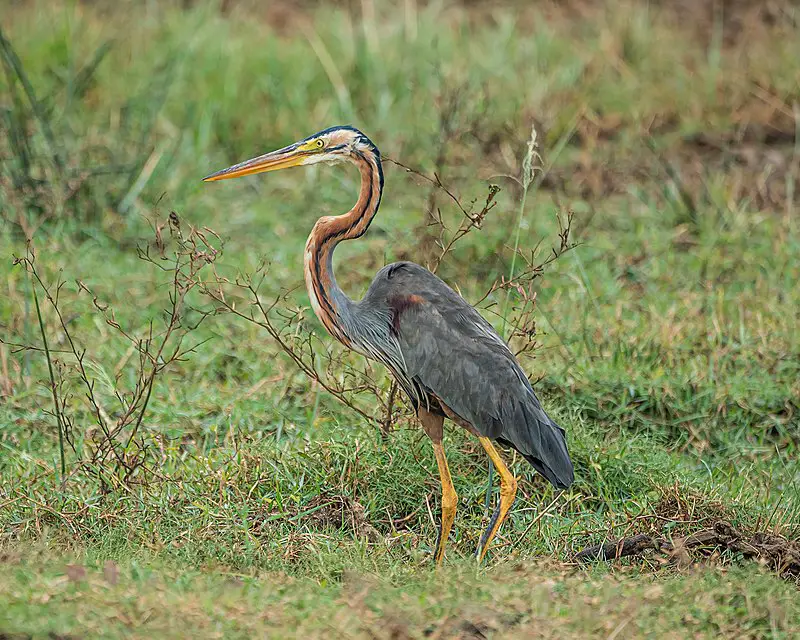
The Purple Heron is a majestic wading bird from the heron family that can be found in Africa, central and southern Europe, as well as southern and eastern Asia.
It has an impressive wingspan of up to 1.2 meters and its plumage usually ranges from grey-blue to purple on its back with brown streaks on its chest.
This species breeds during the summer months before migrating to winter habitats where they feed mainly on fish or frogs near wetlands or rivers.
The scientific name Ardea purpureus originates from Latin words meaning ‘heron’ and ‘colored purple’ respectively – referring to this bird’s beautiful coloration.
Scientific classification:
| Kingdom | Animalia |
| Phylum | Chordata |
| Class | Aves |
| Order | Pelecaniformes |
| Family | Ardeidae |
| Genus | Ardea |
| Species | A. purpurea |
18. Goliath Heron
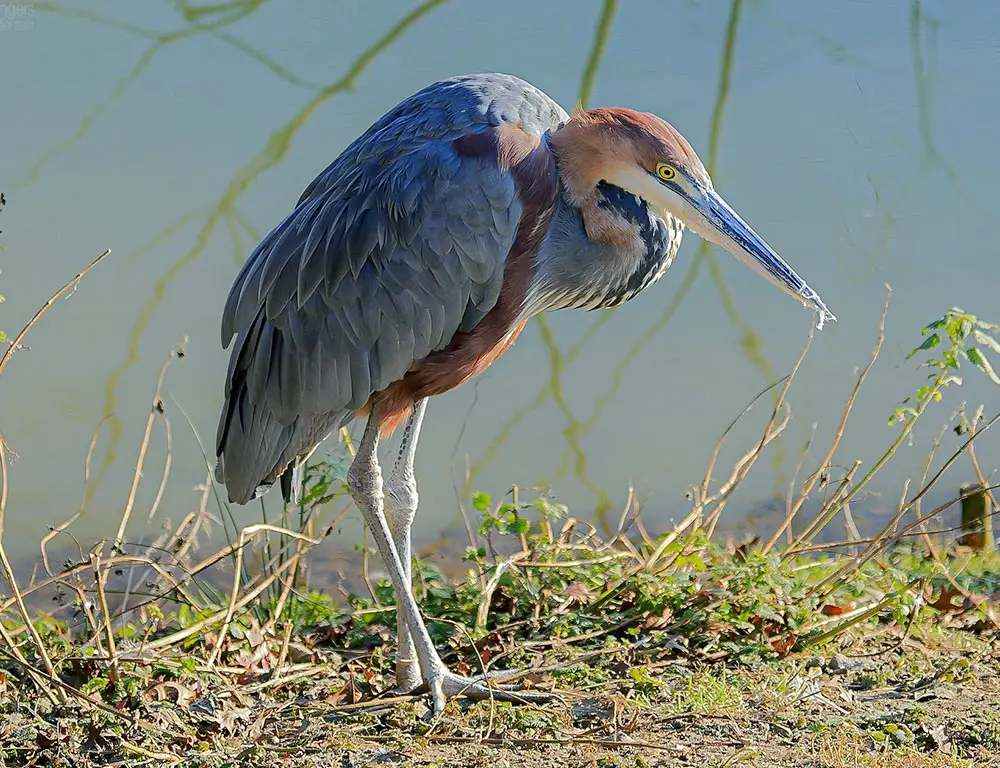
The Goliath Heron is the world’s largest living heron species, found in sub-Saharan Africa and in smaller numbers in Southwest and South Asia. It stands up to 5 feet tall with a wingspan of over 6 feet wide.
Its bill is long and yellowish-orange while its head has white plumes that point backward along its neck. Its back, scapulars, and tail feathers are dark gray or black while it has lighter gray wing coverts and primaries.
The body plumage ranges from light grey to brownish grey depending on age; younger birds have more whitish coloration than adults do.
This bird preys on fish as well as amphibians, crustaceans, insects, reptiles, and small mammals near water sources such as wetlands or lakesides—it also visits agricultural land for carrion at times.
Scientific classification:
| Kingdom | Animalia |
| Phylum | Chordata |
| Class | Aves |
| Order | Pelecaniformes |
| Family | Ardeidae |
| Genus | Ardea |
| Species | A. goliath |
19. Indian Pond Heron
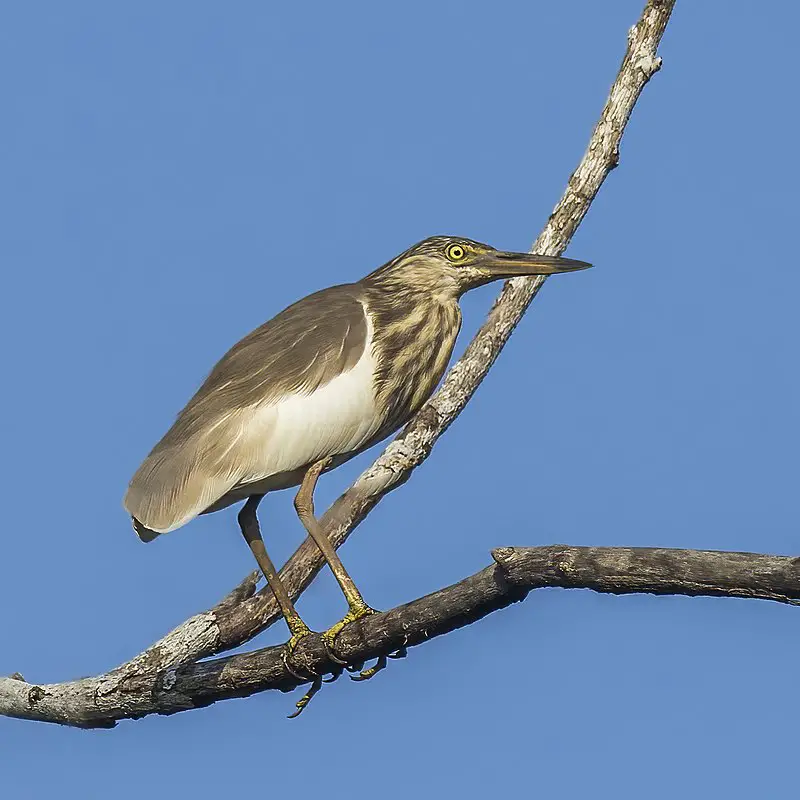
The Indian Pond Heron, also called Paddybird is a small heron found in the Old World. It breeds from southern Iran to India, Burma, and Sri Lanka and can be seen near waterbodies or even around human habitations.
These birds are easily recognizable when they take off as their wings make a loud whistling sound due to their long flight feathers which are greyish-brown with white patches on them.
They feed mainly on fish but will eat other aquatic creatures such as frogs and insects too.
During breeding season they construct nests made of reeds close to water bodies where they lay 3–5 eggs at once.
The female incubates the eggs for about 19 days after which both parents share duties of feeding chicks until juveniles become independent enough to fly away.
Scientific classification:
| Kingdom | Animalia |
| Phylum | Chordata |
| Class | Aves |
| Order | Pelecaniformes |
| Family | Ardeidae |
| Genus | Ardeola |
| Species | A. grayii |
20. Boat-Billed Heron
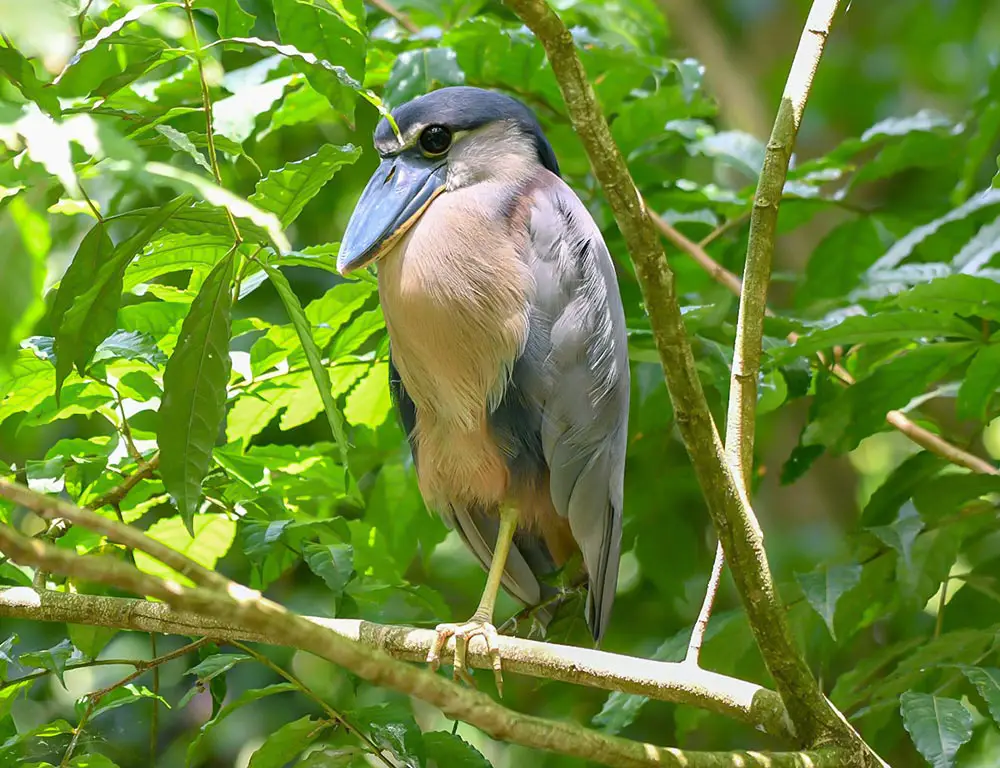
The Boat-billed Heron is a unique member of the heron family, living in mangrove swamps from Mexico to Peru and Brazil. It has an atypical bill shape compared to other members of its family which gives it its name.
Due to its nocturnal behavior, this bird breeds semi-colonially in mangrove trees during the night and lays two to four blue eggs per clutch that take around three weeks for incubation.
This species also exhibits some interesting hunting techniques such as spreading out its wings while standing still on branches or even submerging itself partially into water until prey passes by within reach; so they can snatch them quickly with their long beaks.
Conservation efforts must continue due to threats posed by habitat loss and human disturbance.
Scientific classification:
| Kingdom | Animalia |
| Phylum | Chordata |
| Class | Aves |
| Order | Pelecaniformes |
| Family | Ardeidae |
| Subfamily | Tigriornithinae |
| Genus | Cochlearius Brisson, 1760 |
| Species | C. cochlearius |
21. Lava Heron
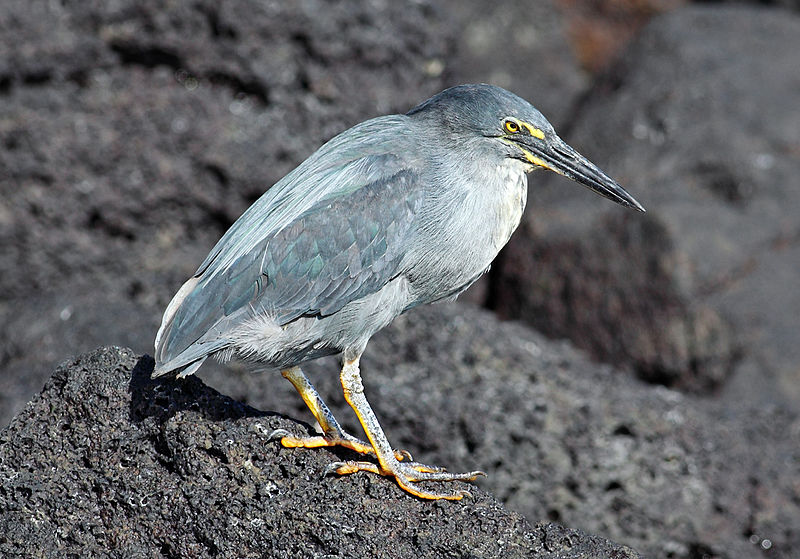
The Lava Heron is a species of heron that is endemic to the Gal�pagos Islands of Ecuador. It has distinctive black and white stripes along its body, giving it the appearance of being striped like lava rock.
Its back feathers are generally brown-grey with shades ranging from dark grey to light blue depending on age and season.
This small heron stands an average height between 20�25 cm (7.9�9.8 inches) tall and weighs around 53 g (1.87 oz).
The diet consists mainly of insects, crustaceans, fish as well as other aquatic animals found near rivers or wetlands where they usually inhabit coastal lagoons or mangroves trees for nesting sites during the breeding season.
which occurs annually at different times on each island group within the archipelago region throughout most months out year round excluding winter when rainfall increases significantly.
Scientific classification:
| Kingdom | Animalia |
| Phylum | Chordata |
| Class | Aves |
| Order | Pelecaniformes |
| Family | Ardeidae |
| Genus | Butorides |
| Species | B. sundevalli |
Also Featured In: Galapagos Birds You Should Know, Birds of Galápagos Islands You Need to Know
22. Nankeen Night Heron
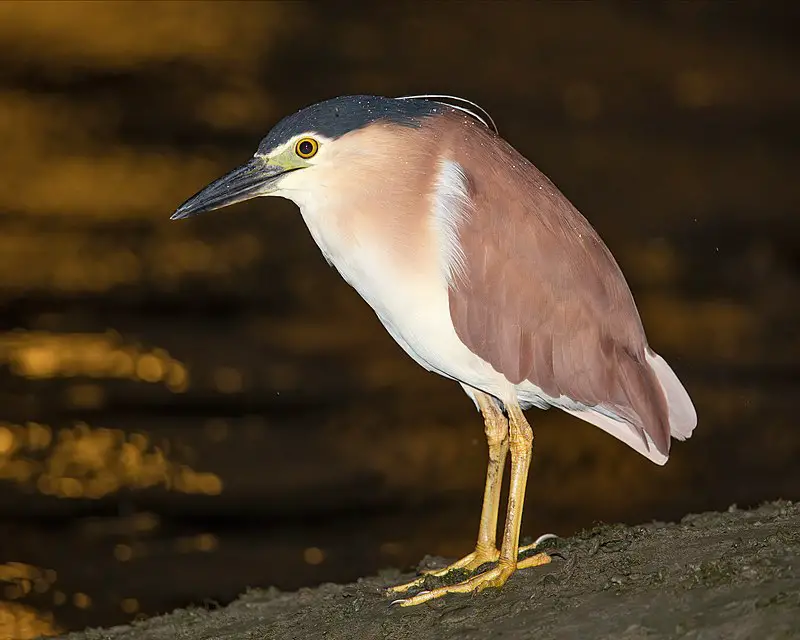
The Nankeen night heron is a beautiful bird with a distinct reddish-brown color. It can be found in an impressive range of habitats, including forests, meadows, shores, and swamps.
Primarily nocturnal by nature, these birds are most active during the dark hours of the day.
Measuring between 55 to 65 cm long they have broad wings which help them soar through the air gracefully at great speeds when hunting for food or migrating across continents.
Their diet primarily consists of small fish and other aquatic creatures that live in lakes or rivers near their homes.
For many people living near water sources like ponds or streams, this species has become a familiar sight as it often comes out to feed on insects at dusk.
Scientific classification:
| Kingdom | Animalia |
| Phylum | Chordata |
| Class | Aves |
| Order | Pelecaniformes |
| Family | Ardeidae |
| Genus | Nycticorax |
| Species | N. caledonicus |
Also Featured In: Birds that Live around Victoria, Common Melbourne Birds
23. Little Bittern
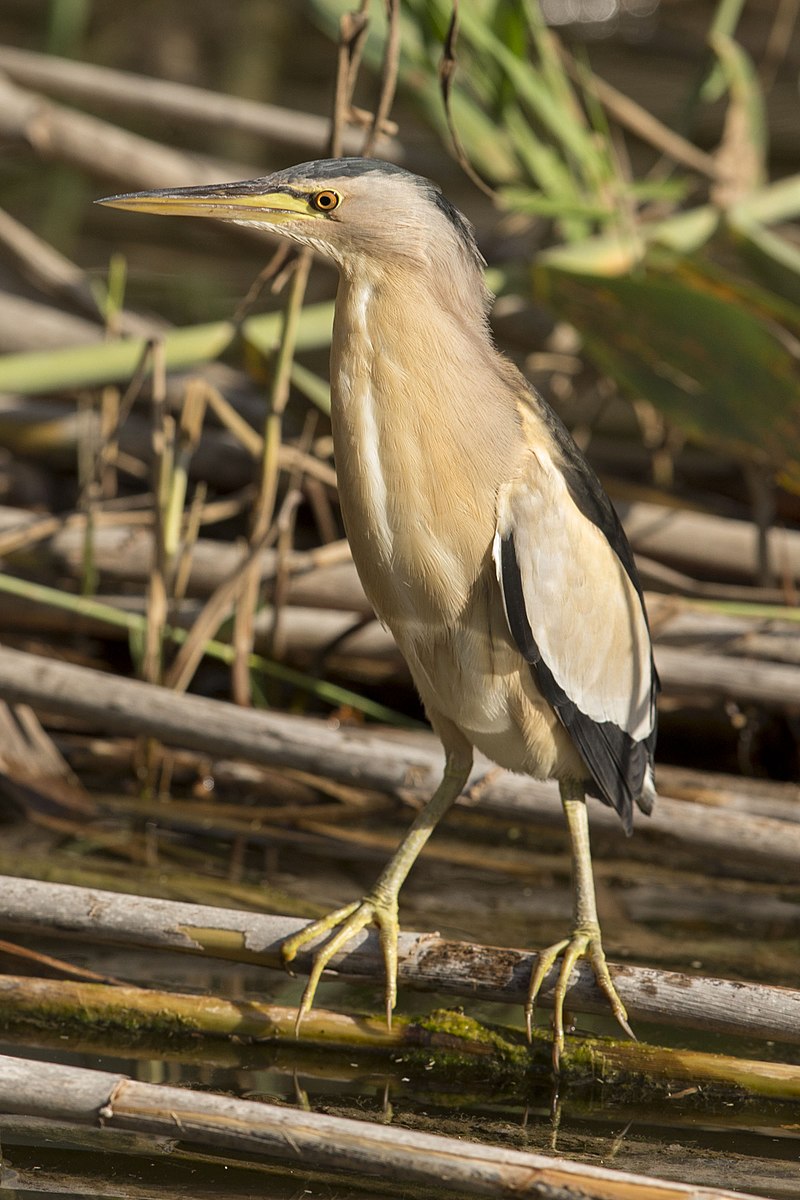
The Little Bittern is a wading bird in the heron family, Ardeidae. Its scientific name Ixobrychus minutus comes from Ancient Greek ixias and Latin for “small” respectively.
It breeds across Africa, central and southern Europe, western and southern Asia as well as Madagascar.
The Little bittern has an orange-brown back with streaks of black while its underside is white with dark stripes running down its sides giving it excellent camouflage to hide amongst reeds or tall grasses near shallow water bodies such as wetlands where they search for food like fish, frogs, etc.
They are usually very shy birds but during mating season males make loud croaking calls that can be heard up to 400m away.
These beautiful little creatures have sadly been classified by the International Union for Conservation of Nature (IUCN) Red List of Threatened Species due to their declining population caused mainly by habitat destruction through agricultural practices or draining of wetland areas which leads to loss of nesting sites putting them at risk.
Scientific classification:
| Kingdom | Animalia |
| Phylum | Chordata |
| Class | Aves |
| Order | Pelecaniformes |
| Family | Ardeidae |
| Genus | Ixobrychus |
| Species | I. minutus |
24. Western Reef Heron
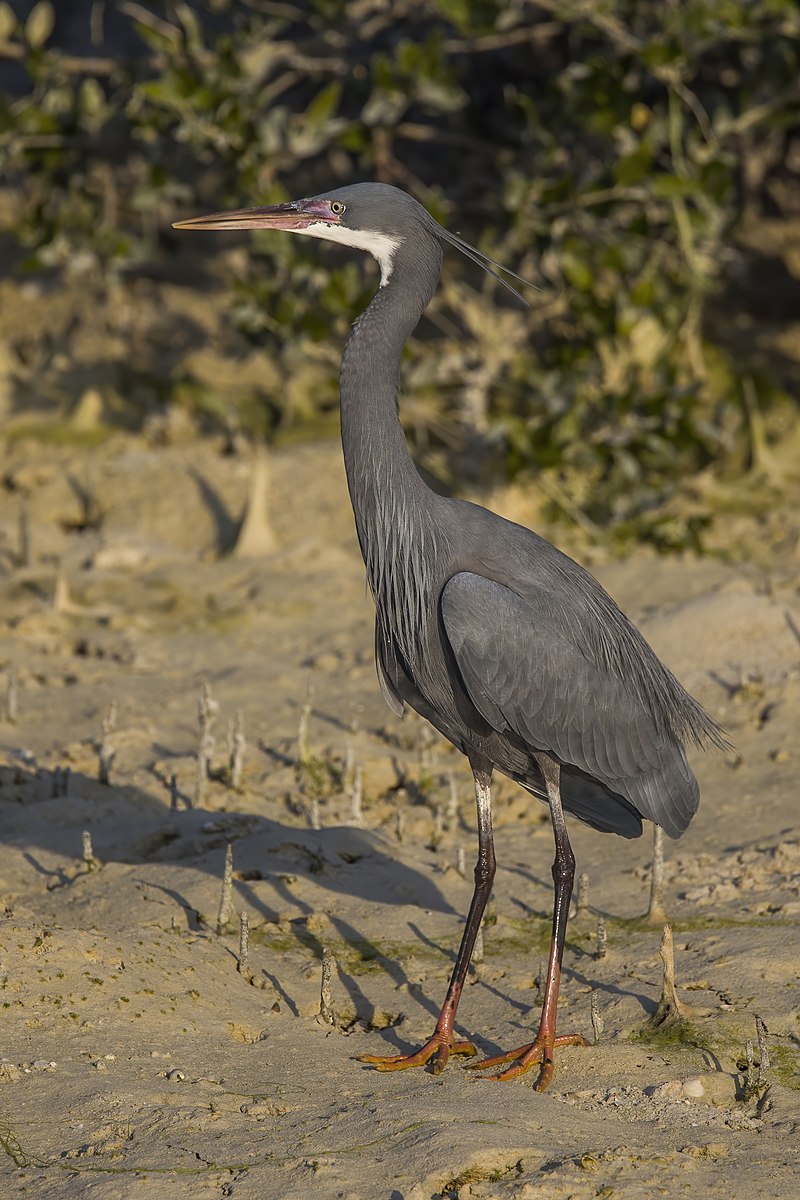
The western reef heron, also known as the western reef egret, is a medium-sized bird found in southern Europe, Africa, and some parts of Asia. It usually inhabits coastal areas and has two distinctive plumage forms.
The slaty-grey form can be mistaken for the rare dark morph of the Little Egret while its white form looks similar to that of an immature Grey Heron.
This species feeds mainly on fish but will occasionally eat insects or other small aquatic animals like crabs and mollusks too.
Western Reef Herons are solitary birds that nest near water bodies where they build nests from sticks which may sometimes contain feathers or seaweed as well.
They have become endangered since their habitats have been destroyed due to human activities such as building developments along coastlines; however, conservation efforts are being taken to ensure their survival into future generations.
Scientific classification:
| Kingdom | Animalia |
| Phylum | Chordata |
| Class | Aves |
| Order | Pelecaniformes |
| Family | Ardeidae |
| Genus | Egretta |
| Species | E. gularis |
25. White-Faced Ibis
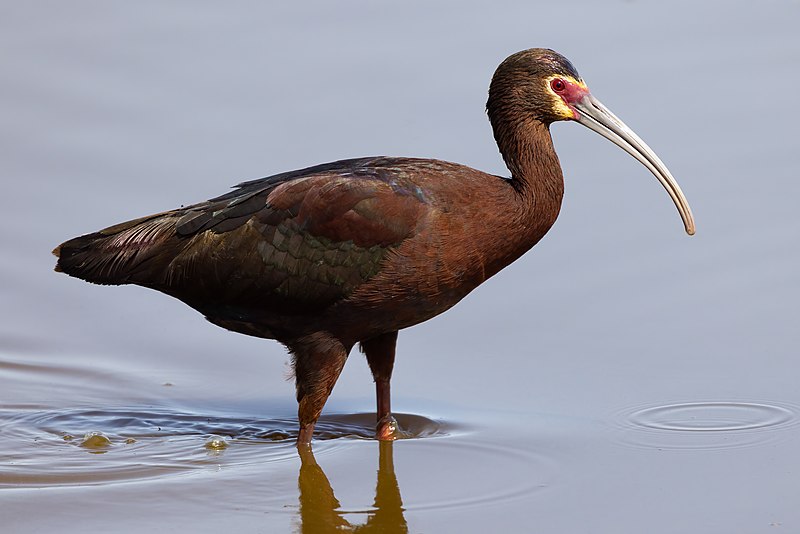
The White-faced Ibis is a species of wading bird belonging to the ibis family. It breeds in marshes, nesting on low trees or bushes.
The breeding range for this species stretches from the western United States south through Mexico, and from southeastern Brazil and Bolivia down to central Argentina and along the coast of Chile.
Its wintering grounds include coastal California, northern Arizona, New Mexico as well as Central America; it also occasionally occurs further north than usual due to favorable conditions.
This beautiful bird has white plumage with bronze wings that shine when seen under sunlight. Furthermore, its head is adorned by an unmistakable white face patch which gives it its name—White-faced Ibis.
Scientific classification:
| Kingdom | Animalia |
| Phylum | Chordata |
| Class | Aves |
| Order | Pelecaniformes |
| Family | Threskiornithidae |
| Genus | Plegadis |
| Species | P. chihi |
26. Yellow Bittern
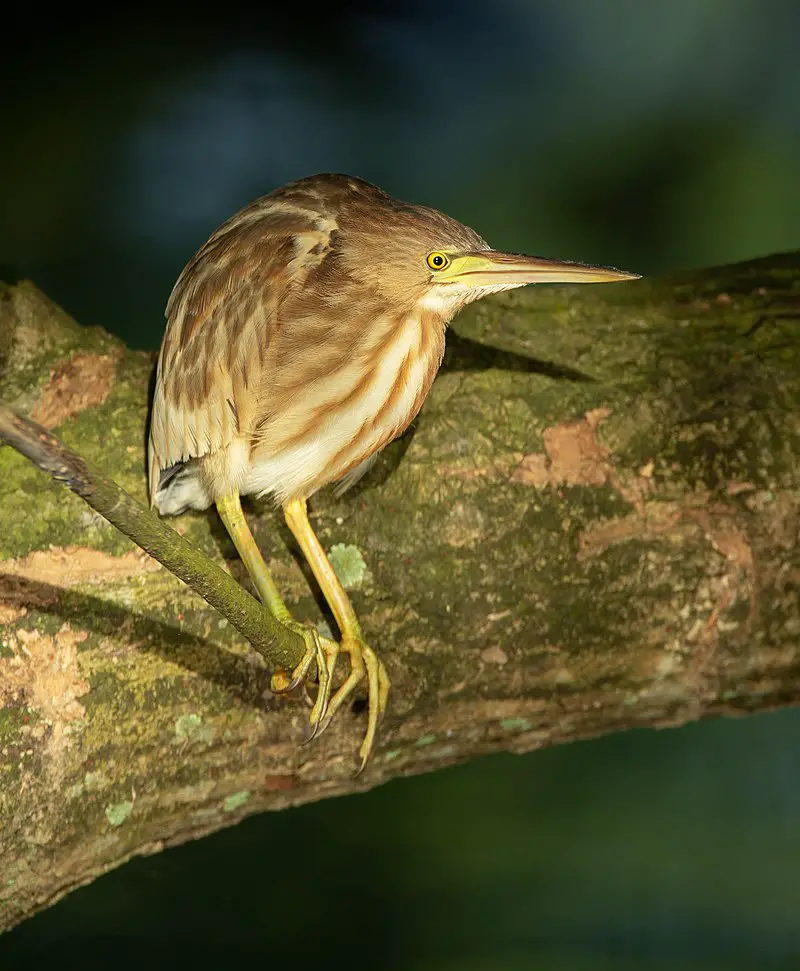
The yellow bittern is a small, Old World bird that breeds in parts of the Indian Subcontinent and East Asia. It can be found as far east as Russia and Japan, with some northern birds migrating short distances during winter.
This species has also been recorded as an unexpected vagrant to Alaska and Great Britain – one single sighting was documented at Radipole Lake in Dorset on November 23rd, 1962.
Its feathers are primarily golden brown, with black streaks along its back contrasting against its bright chestnut-yellow neck patch; juvenile plumage appears duller but still shows distinctive markings.
Yellow bitterns feed mainly on fish or amphibians from shallow water sources such as marshes or swamps; they use their long bill to probe for prey hidden amongst reeds or grasses before seizing it quickly with their sharp talons.
Scientific classification:
| Kingdom | Animalia |
| Phylum | Chordata |
| Class | Aves |
| Order | Pelecaniformes |
| Family | Ardeidae |
| Genus | Ixobrychus |
| Species | I. sinensis |
Also Featured In: Guam Birds You Need to See, Common Birds that Live in Odisha
27. White-Necked Heron
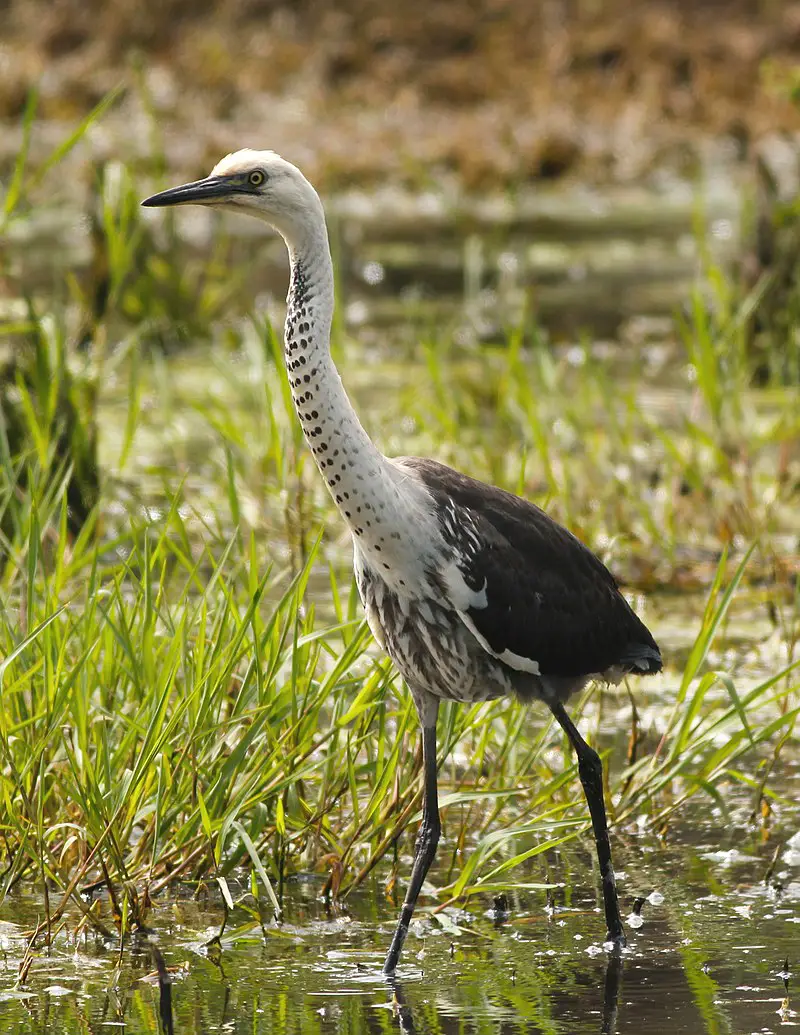
The white-necked heron, or Pacific heron, is a species of large water bird found across much of Australia. It has also been spotted in Indonesia, New Guinea, and New Zealand but is rarer in Tasmania.
These birds are nomadic by nature and move from one water source to the next depending on availability.
They have long legs which enable them to wade through shallow waters looking for prey such as fish, crustaceans, and insects.
Their feathers are greyish with a distinctive white neck patch that gives these birds their name – they can be seen standing tall at the edge of rivers or lakes watching for movement underwater before diving down gracefully into the depths.
Scientific classification:
| Kingdom | Animalia |
| Phylum | Chordata |
| Class | Aves |
| Order | Pelecaniformes |
| Family | Ardeidae |
| Genus | Ardea |
| Species | A. pacifica |
Also Featured In: Birds that Live around Brisbane, Common Townsville Birds
28. Chinese Pond Heron
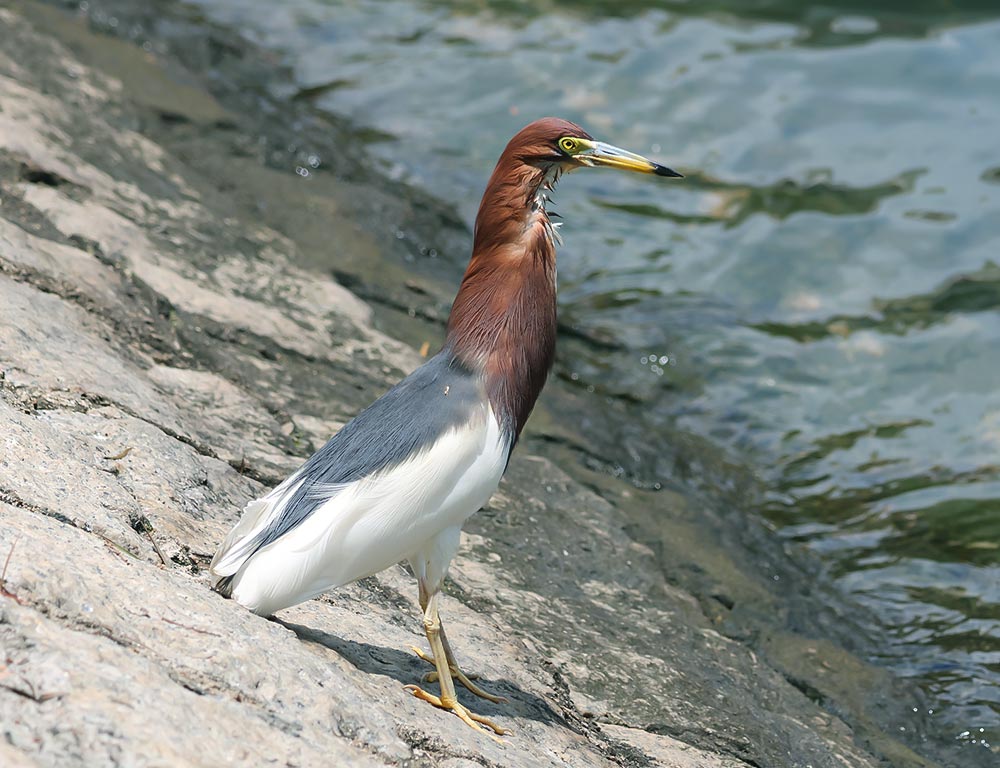
The Chinese pond heron (Ardeola bacchus) is a species of freshwater bird belonging to the heron family, Ardeidae.
It is one of six “pond herons” that inhabit East Asia and can be found in parts of China, Japan, and Korea.
This species typically inhabits shallow marshes, flooded fields, or rice paddies near rivers and streams where it feeds on small fish, frogs, insects, and other aquatic life forms.
Its plumage features white feathers with black tips creating an elegant look when perched by the water’s edge waiting for prey.
The Chinese pond heron has been known to form mixed-species flocks which include egrets as well as other wading birds such as storks; its presence adds interest to any wetland habitat they call home.
Scientific classification:
| Kingdom | Animalia |
| Phylum | Chordata |
| Class | Aves |
| Order | Pelecaniformes |
| Family | Ardeidae |
| Genus | Ardeola |
| Species | A. bacchus |
29. Intermediate Egret
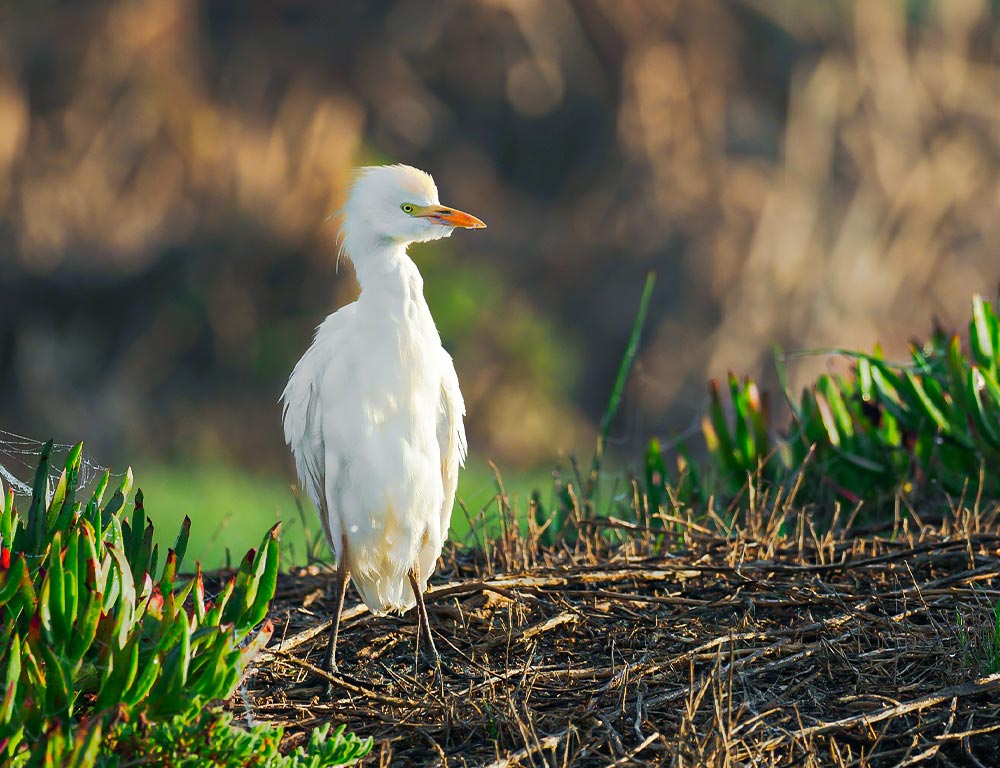
The Intermediate Egret is a medium-sized heron native to East Africa, the Indian subcontinent, Southeast Asia and Australia. It has a yellow bill with a black tip, chestnut legs, and feet.
Its plumage varies from white in the breeding season to greyish or brownish non-breeding season. It feeds on small fish, insects, and frogs near freshwater habitats such as lakes, marshes, and ponds.
They are commonly seen perched atop tall trees where they hunt for prey during low tides in estuarine areas like mudflats or mangrove swamps.
During nesting time they build nests of sticks high up in trees which can be reused year after year if left undisturbed by humans or predators.
The Intermediate Egret is an adaptable bird that offers great potential for conservation efforts due to its wide range across different continents.
Scientific classification:
| Kingdom | Animalia |
| Phylum | Chordata |
| Class | Aves |
| Order | Pelecaniformes |
| Family | Ardeidae |
| Genus | Ardea |
| Species | A. intermedia |
30. Capped Heron
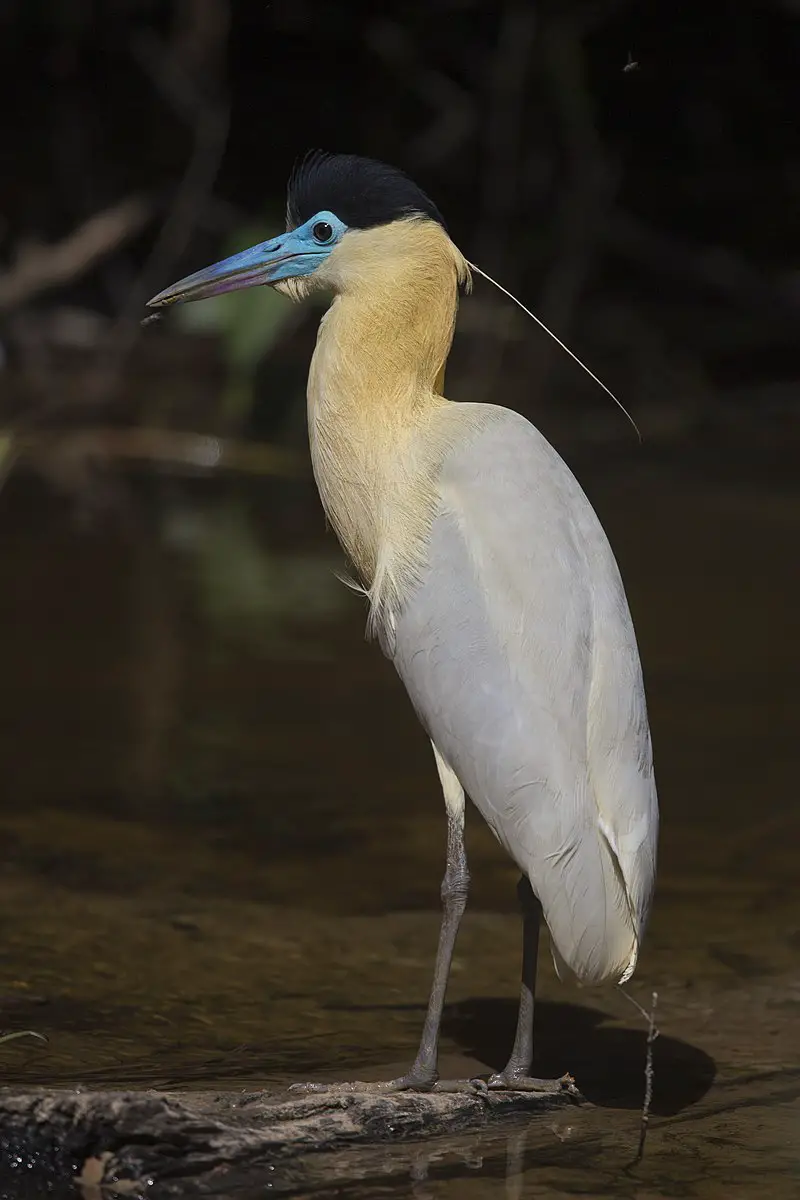
The Capped Heron is a majestic bird endemic to the neotropics, found in rainforests from Panama to Brazil.
It’s an intriguing member of the heron family (Ardeidae), and stands out due to its unique appearance – it looks similar to night herons but is active during daytime or twilight.
This species has been poorly studied, thus little information is available about this elusive bird. What we do know though suggests that they are most likely solitary birds, nesting alone near water sources such as rivers or lakes.
They feed mainly on small fish and amphibians which they catch with their long beaks while standing at shallow watersides.
Their plumage can range from greyish-browns to dark blues depending on season and age; juveniles have distinctive white cap feathers atop their heads giving them quite a striking look.
Scientific classification:
| Kingdom | Animalia |
| Phylum | Chordata |
| Class | Aves |
| Order | Pelecaniformes |
| Family | Ardeidae |
| Subfamily | Ardeinae |
| Genus | Pilherodius Reichenbach, 1853 |
| Species | P. pileatus |
31. Glossy Ibis
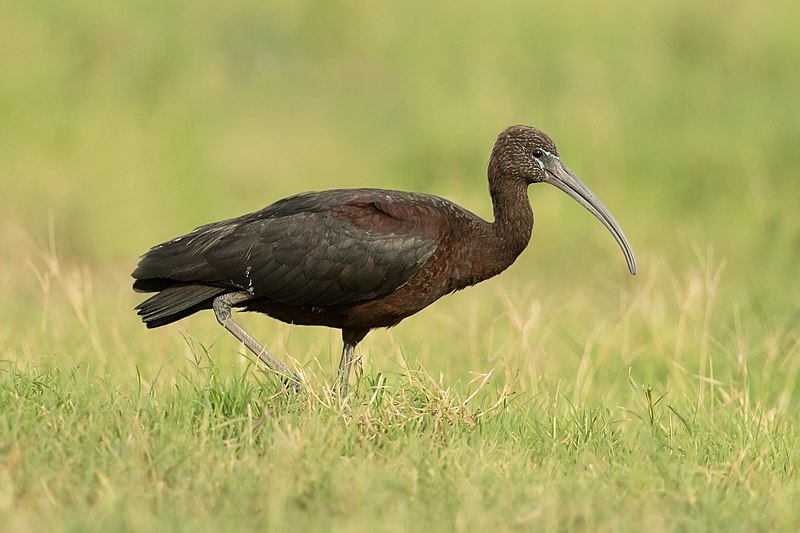
The Glossy Ibis is a water bird that belongs to the family Threskiornithidae. It has a unique bill in the shape of a sickle, which gave it its scientific name – Plegadis falcinellus.
It can be found widely across Europe, Asia, and Africa, with scattered nesting sites in warm regions.
Its feathers are black-brown on top and chestnut brown from below; its wings have a glossy greenish-purple sheen when seen from afar.
They mainly feed on small insects like grasshoppers, spiders or earthworms as well as crustaceans or amphibians caught while wading through shallow waters.
During breeding season they also consume plant material such as rice grains or corn kernels provided by humans near habitat areas where they nest.
Scientific classification:
| Kingdom | Animalia |
| Phylum | Chordata |
| Class | Aves |
| Order | Pelecaniformes |
| Family | Threskiornithidae |
| Genus | Plegadis |
| Species | P. falcinellus |
32. Squacco Heron
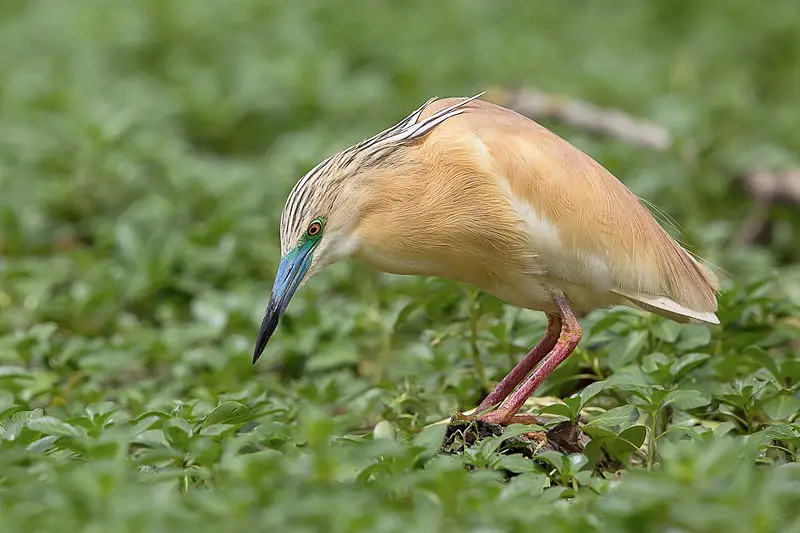
The Squacco Heron is a small heron species native to the Old World that breeds in parts of Europe and the Greater Middle East, before migrating south for winter.
They measure around 44-47 cm long with an 80-92 cm wingspan, making them one of the smaller species of herons.
Their body length measures 20-23cm while they have greyish or brown plumage on top and white or yellow underneath.
The neck has some streaking patterns giving it its name “squacco” which means speckled in Italian. It feeds mainly on fish, frogs, and insects near shallow waters such as marshes, swamps, and streams.
Rarely sighted north of their breeding grounds this curious little bird should be admired if spotted.
Scientific classification:
| Kingdom | Animalia |
| Phylum | Chordata |
| Class | Aves |
| Order | Pelecaniformes |
| Family | Ardeidae |
| Genus | Ardeola |
| Species | A. ralloides |
33. Pacific Reef Heron
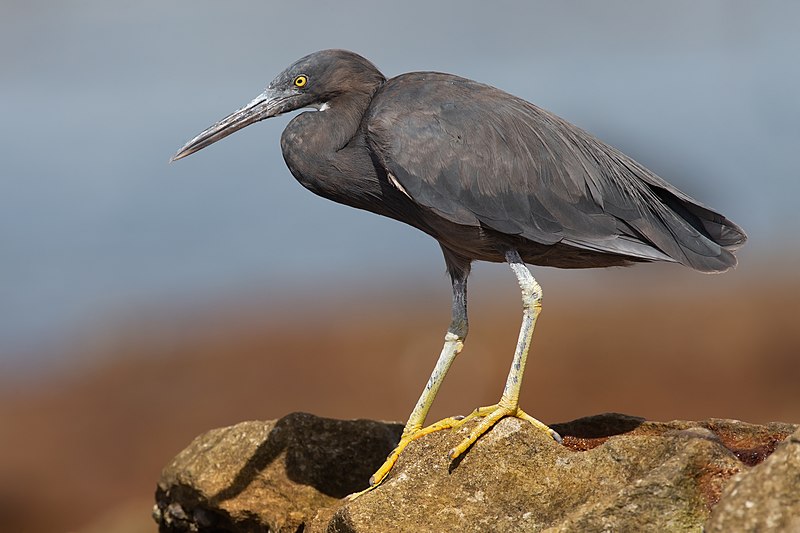
The Pacific reef heron is a species of heron found throughout Southern Asia and Oceania. It has two distinct color morphs, one with slaty grey plumage and the other fully white.
This bird is easily identifiable by its long legs and yellow bill which are used to forage in shallow water bodies.
The sexes look alike except for minor differences such as size or body shape.
They feed on small fish, amphibians, crustaceans, and mollusks that they find near reefs or mangroves where they roost during daytime hours often preening their feathers if disturbed by predators like hawks or eagles.
When breeding season arrives these birds become more vocal using loud honking calls to attract mates before settling down into nests built among trees around wetlands or coastal areas.
Scientific classification:
| Kingdom | Animalia |
| Phylum | Chordata |
| Class | Aves |
| Order | Pelecaniformes |
| Family | Ardeidae |
| Genus | Egretta |
| Species | E. sacra |
34. Cocoi Heron
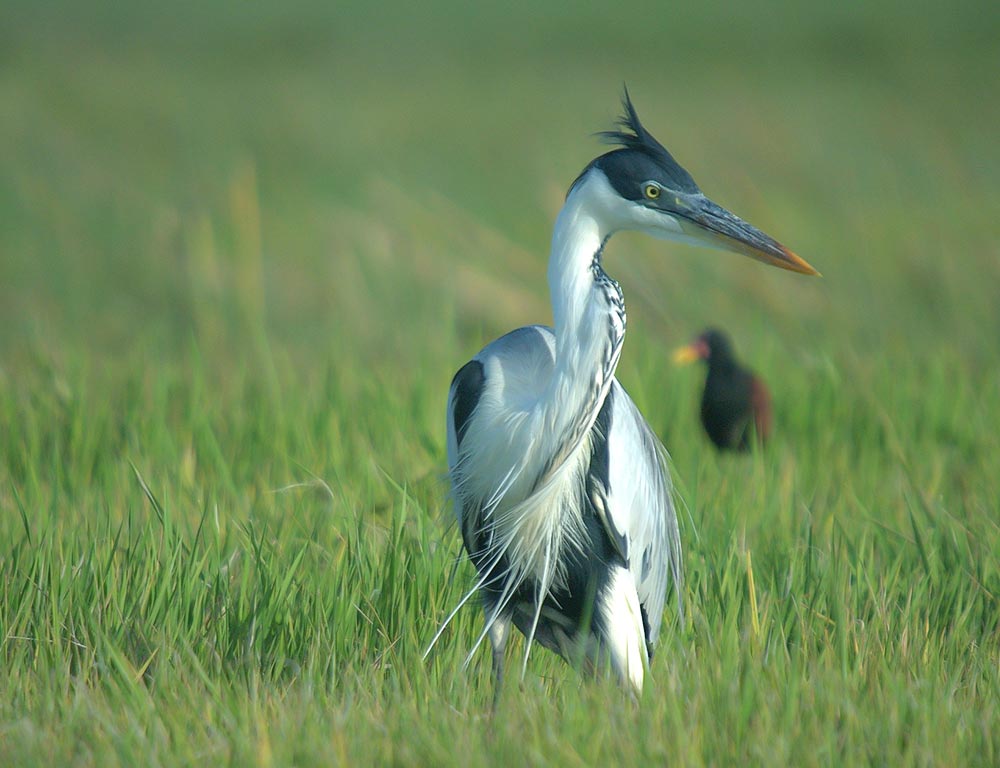
The Cocoi Heron is a majestic wading bird found in South America. It has a distinctive pale grey plumage and darker grey crest, making it easily recognizable among other herons.
This carnivore hunts for fish and crustaceans in shallow water with its long legs, giving the appearance of gracefulness even while feeding.
The origin of this species’ name remains unknown despite being first described by Carl Linnaeus back in 1766 as part of his 12th edition Systema Naturae publication.
The Cocoi Heron continues to captivate onlookers today due to its elegant beauty and remarkable hunting skills.
Scientific classification:
| Kingdom | Animalia |
| Phylum | Chordata |
| Class | Aves |
| Order | Pelecaniformes |
| Family | Ardeidae |
| Genus | Ardea |
| Species | A. cocoi |
35. Eurasian Bittern
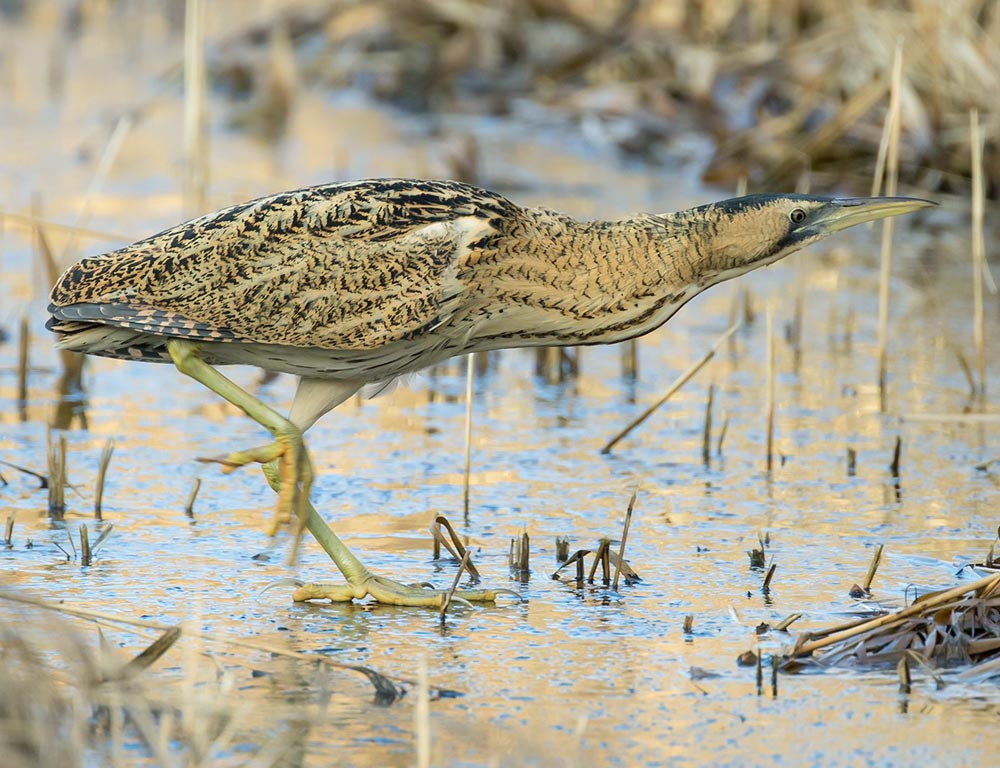
The Eurasian Bittern is a large and secretive wading bird of the heron family. It has two subspecies, one found in Europe and northern Africa, while another can only be seen in parts of southern Africa.
This migratory species spends its winters southwards from its breeding grounds across much of Europe to eastern Asia as far south as China.
The male bitterns are easily identifiable by their loud booming calls that they make during mating season which is usually between April and May.
They have brown striped plumage with lighter underparts which helps them blend into marshy habitats where they feed on fish and amphibians among other prey items.
Despite having a relatively wide distribution range, this species remains threatened due to habitat destruction caused by human activities such as wetland drainage for agricultural use or development projects like dams, etc, making conservation efforts necessary for securing their future survival.
Scientific classification:
| Kingdom | Animalia |
| Phylum | Chordata |
| Class | Aves |
| Order | Pelecaniformes |
| Family | Ardeidae |
| Genus | Botaurus |
| Species | B. stellaris |
36. Great-Billed Heron
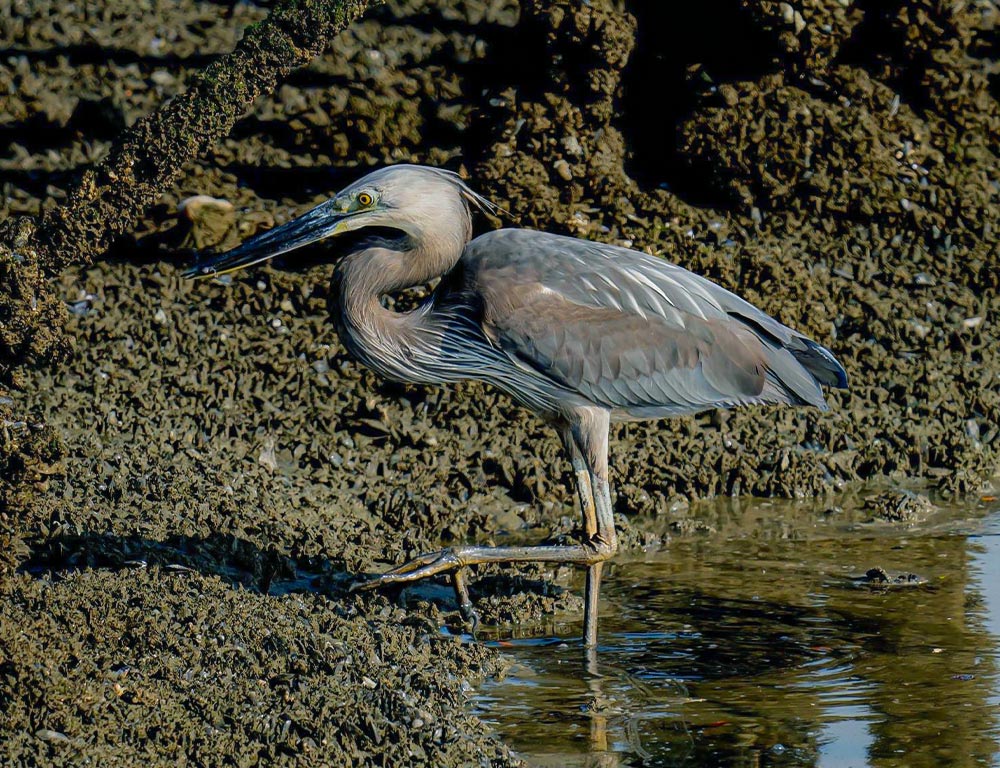
The Great-billed Heron is a majestic bird of the heron family found in Southeast Asia, Papua New Guinea, and Australia.
Standing at an impressive 115cm tall and weighing up to 2.6kg, this magnificent creature is larger than the Purple Heron with which it shares many similarities including its dark grey plumage above and white feathers below its wings.
Its distinguishing features however are its huge yellow bill as well as large black legs ending in webbed feet that allow for easy movement through shallow water while hunting prey such as fish or frogs.
A formidable hunter during daylight hours but also known to be quite vocal at night time.
Scientific classification:
| Kingdom | Animalia |
| Phylum | Chordata |
| Class | Aves |
| Order | Pelecaniformes |
| Family | Ardeidae |
| Genus | Ardea |
| Species | A. sumatrana |
Also Featured In: Birds That Live In Phuket Island, Native Birds Of Mackay
37. Javan Pond Heron
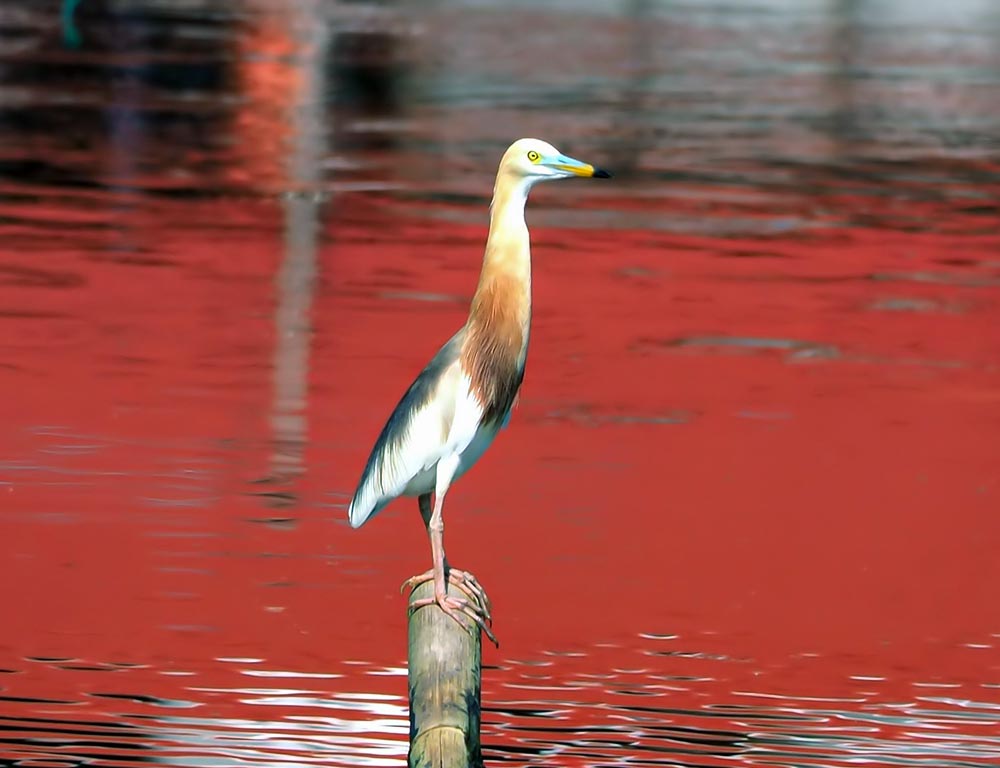
The Javan Pond Heron is a beautiful wading bird that can be found in shallow fresh and salt-water wetlands of Southeast Asia.
It has an overall orange, slaty, and white coloring during mating season with a yellow bill, black tip on its bill, and yellow eyes.
Its length typically measures 45 cm long with white wings. The heron’s diet consists mainly of insects, fish, crabs as well as any other small creatures it may find along the shoreline or water bed where they live.
These birds are usually solitary but can also sometimes gather in groups to hunt for food at dusk when their prey is more active.
They use their keen vision to spot potential prey before quickly darting forward to catch them using their sharp bills.
Scientific classification:
| Kingdom | Animalia |
| Phylum | Chordata |
| Class | Aves |
| Order | Pelecaniformes |
| Family | Ardeidae |
| Genus | Ardeola |
| Species | A. speciosa |
Also Featured In: Birds that Commonly Found in Bali, Common Birds of Lombok
38. Malayan Night Heron
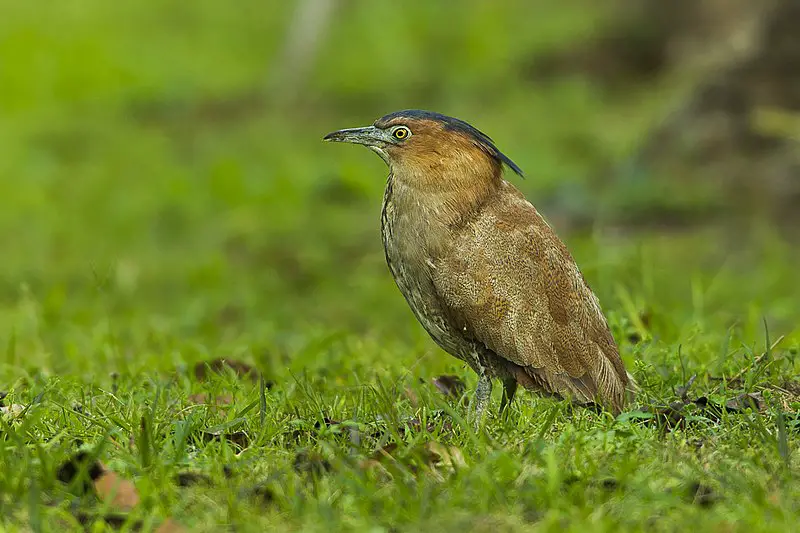
The Malayan night heron is a medium-sized heron found in southern and eastern Asia. It has a distinctive black crest, yellow bill, and brownish plumage with white streaks on the neck.
The species can be seen in India, Sri Lanka, Brunei, Nepal, Bangladesh, Myanmar Cambodia Laos Vietnam Thailand Malaysia Singapore China Indonesia Philippines Taiwan Japan.
Being highly migratory it may also turn up at unexpected localities during its long journey between wintering grounds to breeding areas.
They inhabit wetlands such as marshes, lakes riverbanks where they feed primarily on aquatic insects fishes amphibians reptiles small mammals crustaceans mollusks worms larvae, etc.
These birds are known for their loud croaking calls which help them locate each other while flying or moving through dense vegetation.
Scientific classification:
| Kingdom | Animalia |
| Phylum | Chordata |
| Class | Aves |
| Order | Pelecaniformes |
| Family | Ardeidae |
| Genus | Gorsachius |
| Species | G. melanolophus |
Also Featured In: Most Common Taiwan Birds, Common Birds Found near Ishigaki
39. Von Schrenck’s Bittern
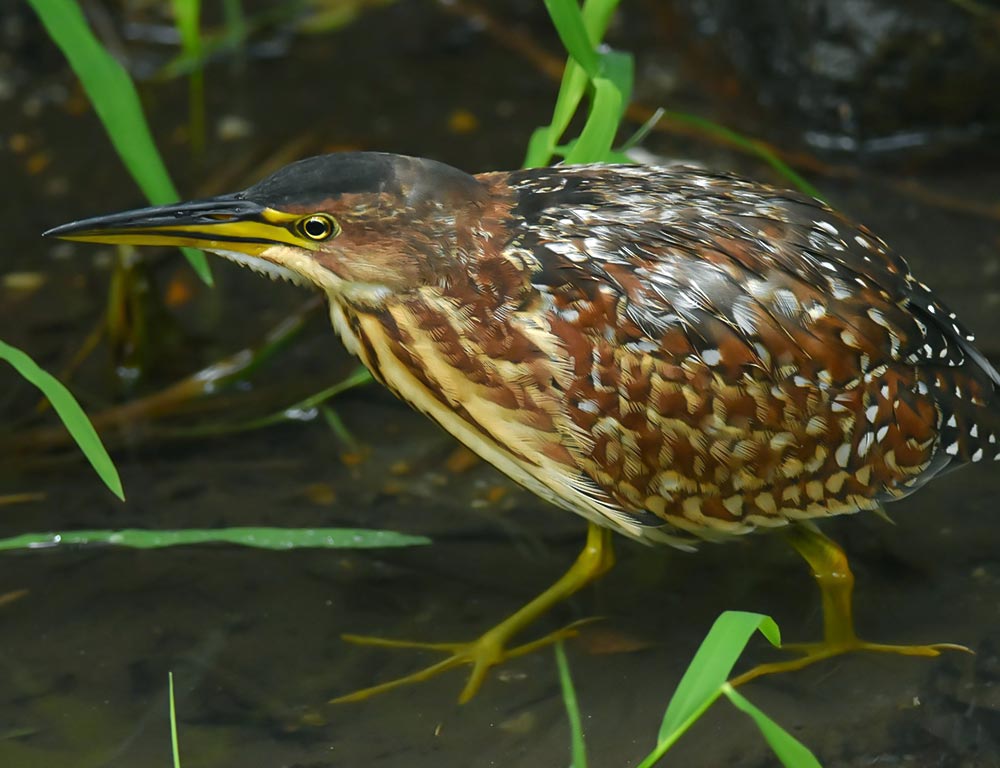
Von Schrenck’s bittern is a small bird of the subfamily Botaurinae, named after 19th-century Russian naturalist Leopold von Schrenck.
The male has chestnut feathers on its upper body and buff coloring below, while the female and juvenile are uniformly chestnut with white speckles above and white streaks below.
When flying it shows two distinctive pale stripes running down each wing from shoulder to tip.
This species primarily inhabits wetlands in eastern Asia such as marshes, shallow lakes, or river edges where it feeds mainly on fish but also frogs, insects, and crustaceans when available.
It nests near water among reeds standing tall enough that they can hide within them for protection against predators like hawks or crows.
Scientific classification:
| Kingdom | Animalia |
| Phylum | Chordata |
| Class | Aves |
| Order | Pelecaniformes |
| Family | Ardeidae |
| Genus | Ixobrychus |
| Species | I. eurhythmus |
Also Featured In: Urban Birds of Hong Kong,
40. Pied Heron
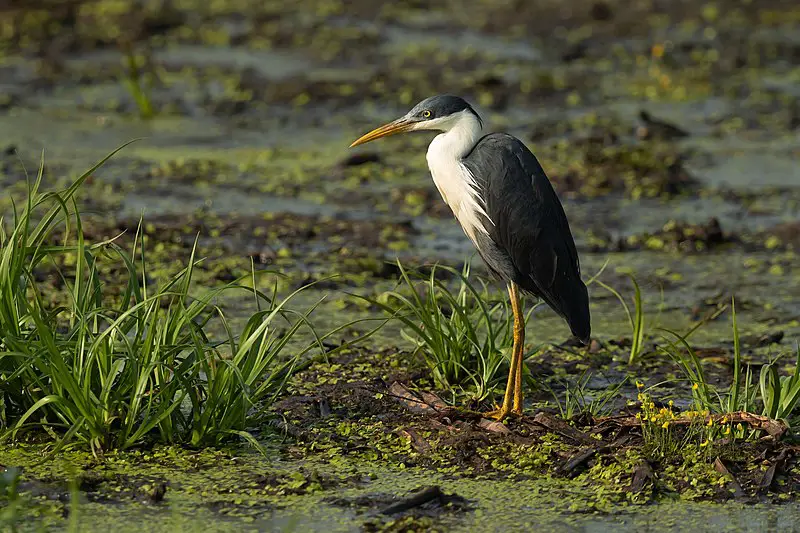
The Pied Heron is a small bird found in coastal and subcoastal areas of northern Australia, Wallacea, and New Guinea. It has no recognized subspecies and was first described by John Gould in 1845.
The average length of the adult heron can range from 43-55 cm long with a wingspan between 68-93cm wide.
Its distinctive appearance comes from its white chestnut body plumage as well as its gray crown feathers that are tipped black making it easily recognisable amongst other birds.
This species feeds on fish, amphibians, rodents, and invertebrates which they hunt both during the day or at night depending on their location and preference for hunting times.
Scientific classification:
| Kingdom | Animalia |
| Phylum | Chordata |
| Class | Aves |
| Order | Pelecaniformes |
| Family | Ardeidae |
| Genus | Egretta |
| Species | E. picata |
41. Australasian Bittern
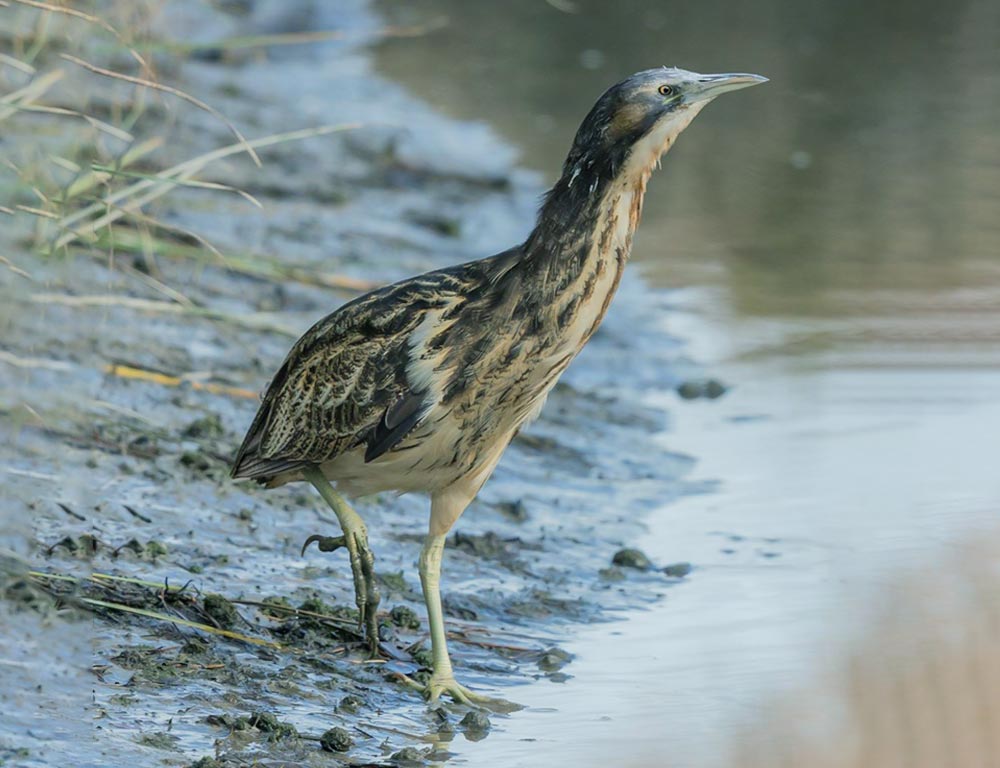
The Tricolored heron is a stunning species of wading bird found in South America, Central America, and the Caribbean. It has an impressive wingspan of 33-37 inches, with its back being dark blue or grey and its chest and belly whitish.
Its neck shows off beautiful streaks of purple, blue, or white colors which give it the name ‘tricolored’. They inhabit marshlands close to bodies of water such as lakes and rivers.
This heron eats mainly small fish but also crustaceans, amphibians, and insects that they catch while slowly stalking through shallow waters using their long legs.
In addition to searching for food during daylight hours, they also hunt at night when most other birds sleep soundly.
The tricolored heron can be seen perched atop tall trees overhanging waterways where it scans the area below before plunging into deeper pools to feed on unsuspecting prey.
Their nests are built up high in palmettos or mangroves near wetlands making them difficult to spot at times.
42. Japanese Night Heron
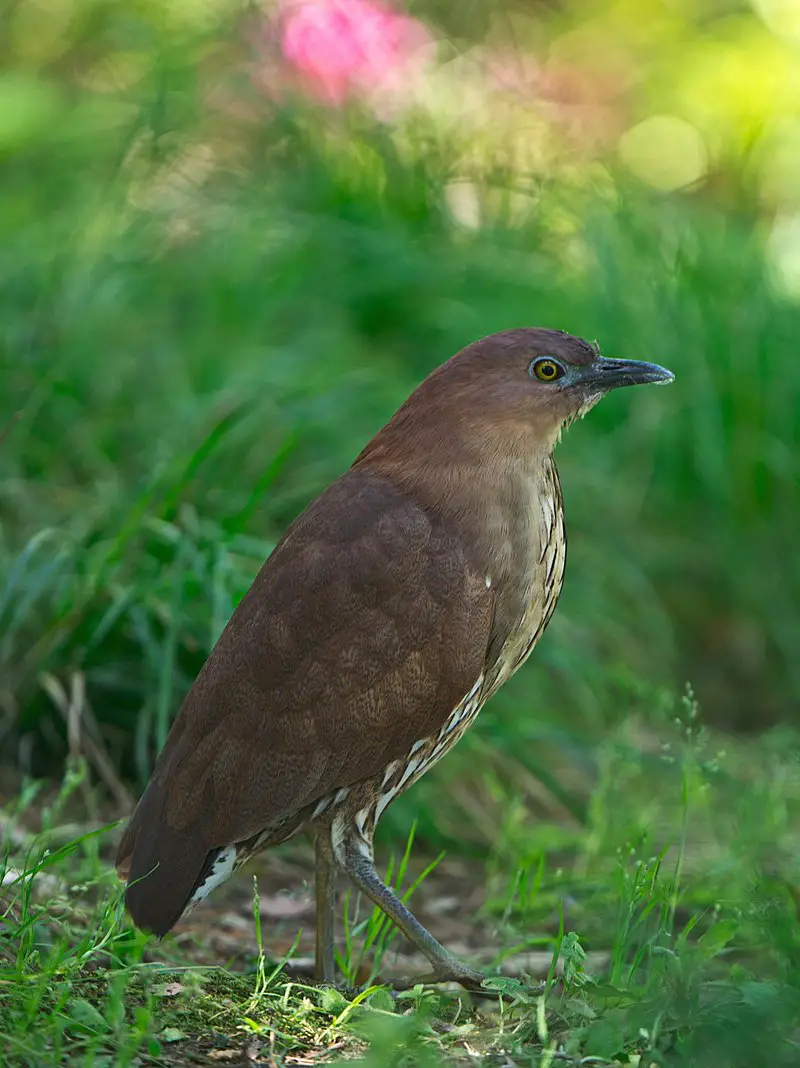
The Japanese night heron is a species of night heron that can be found in East Asia. It breeds mainly in Japan and migrates to the Philippines and Indonesia during the winter season.
During spring and summer, they are also seen in Korea or the Russian Far East. This bird prefers dense forests with high humidity as its habitat for both breeding grounds and wintering sites.
Unfortunately, their population has been declining since the 1970s due to deforestation activities which have destroyed their preferred habitats significantly.
Conservation efforts must be taken soon before this species becomes extinct from our planet earth.
Scientific classification:
| Kingdom | Animalia |
| Phylum | Chordata |
| Class | Aves |
| Order | Pelecaniformes |
| Family | Ardeidae |
| Genus | Gorsachius |
| Species | G. goisagi |
Also Featured In: Samar Island Birds You Should Know, Most Common Birds of Lubang Island
43. Black-Headed Heron
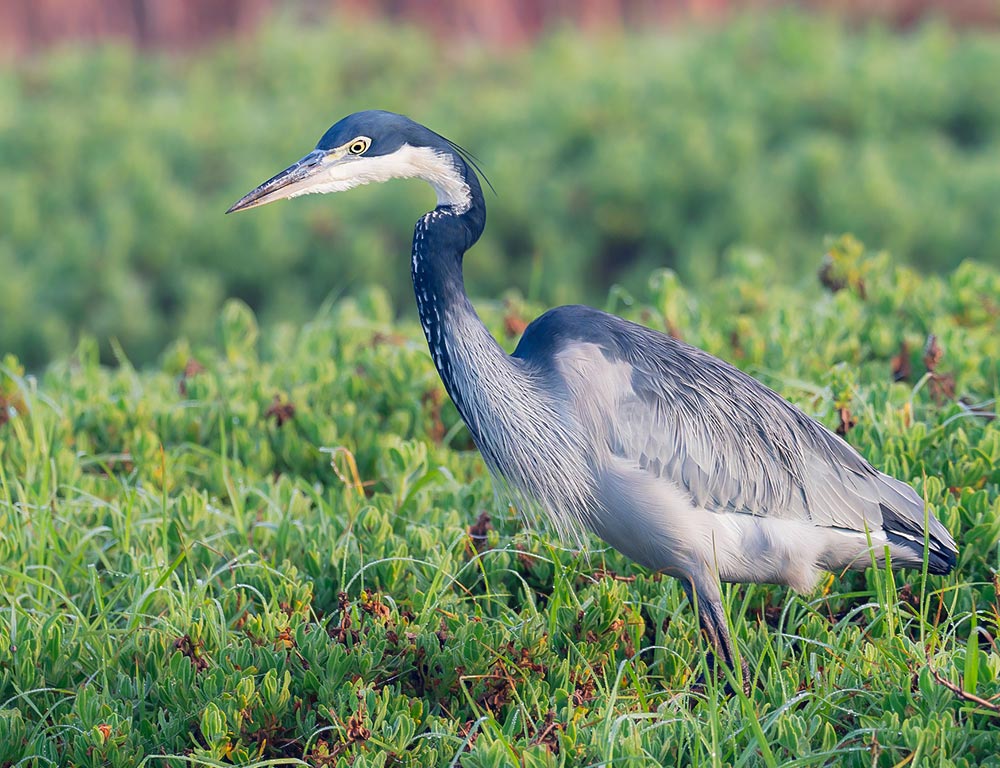
The Black-headed Heron is a wading bird from the heron family Ardeidae, found in sub-Saharan Africa and Madagascar.
It typically resides in wetland areas such as reedbeds or swamps but some birds migrate further north during rainy seasons.
Breeding usually takes place between two to four eggs laid within a bulky stick nest built by both parents.
The Black-headed Heron feeds mainly on small fish, crustaceans, and other aquatic organisms which it catches with its long bill while standing still at the water’s edge or slowly moving around shallow waters.
Its feathers are usually mostly white apart from the black head for which this species has been named and grey wings with distinctive dark patches near the shoulder area giving them an attractive appearance when seen up close.
Scientific classification:
| Kingdom | Animalia |
| Phylum | Chordata |
| Class | Aves |
| Order | Pelecaniformes |
| Family | Ardeidae |
| Genus | Ardea |
| Species | A. melanocephala |
44. White-Faced Heron
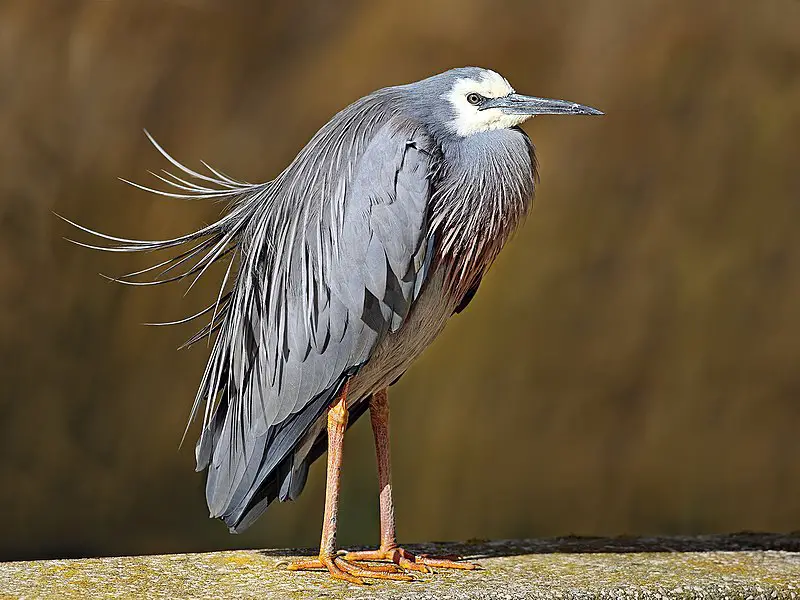
The White-faced Heron is a common sight throughout much of Australasia. With its pale, bluish-grey feathers and yellow legs, this bird stands out in the crowd.
It can be found in New Guinea, Torres Strait Islands, and Indonesia as well as Australia and New Zealand but tends to avoid dry areas. This medium-sized heron has one distinct feature – a white face.
Its diet consists mainly of small fish, lizards, frogs insects, and crustaceans which it hunts for by wading into shallow water or searching through grasses near wetlands.
In flight, they appear graceful with their long neck tucked back against their body giving them an elegant silhouette against the sky.
Their behavior shows intelligence when finding food sources or evading predators making them interesting creatures to observe in nature.
Scientific classification:
| Kingdom | Animalia |
| Phylum | Chordata |
| Class | Aves |
| Order | Pelecaniformes |
| Family | Ardeidae |
| Genus | Egretta |
| Species | E. novaehollandiae |
45. Cinnamon Bittern
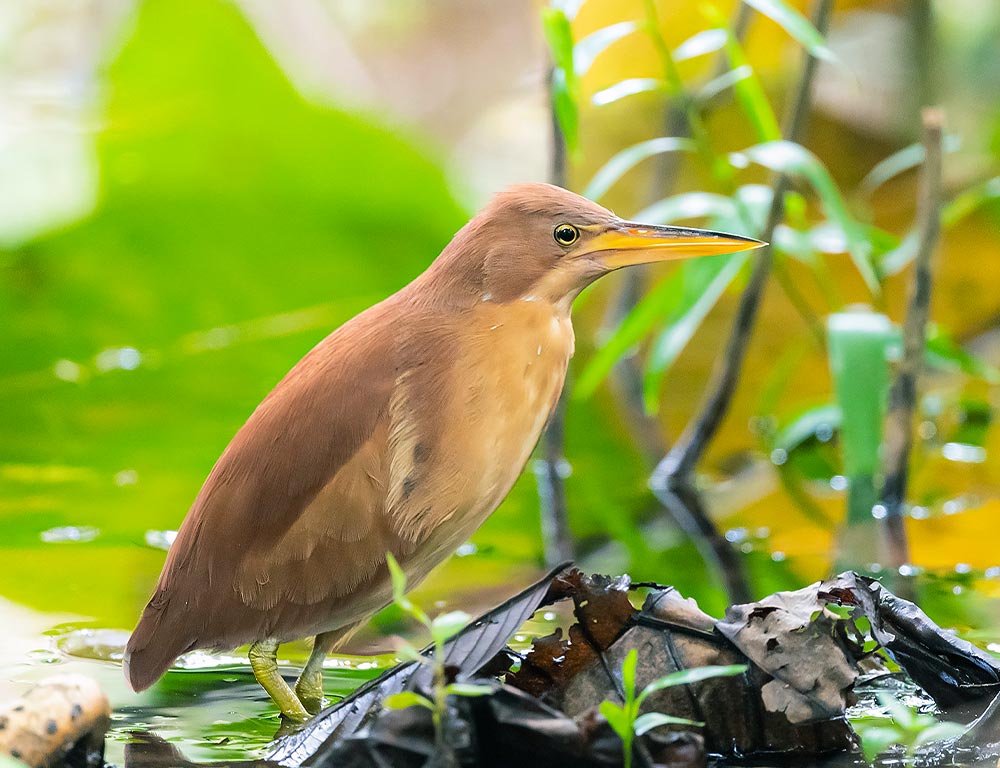
The Cinnamon Bittern is a small Old World bird, found in parts of India, China, and Indonesia. It can be identified by its chestnut brown colour on the back and wings with white streaks throughout.
During breeding season it has yellowish-brown plumage on its head neck and breast. Its legs are black which helps distinguish it from other bitterns.
The cinnamon bittern mainly resides in tropical or subtropical climates but some northern birds migrate short distances during winter months for food sources.
They feed mostly on fish, insects, frogs, and crustaceans while they breed between April to August making nests near shallow water areas under dense vegetation cover providing safety from predators like snakes or cats that may prey upon them otherwise.
Scientific classification:
| Kingdom | Animalia |
| Phylum | Chordata |
| Class | Aves |
| Order | Pelecaniformes |
| Family | Ardeidae |
| Genus | Ixobrychus |
| Species | I. cinnamomeus |
46. Black Bittern
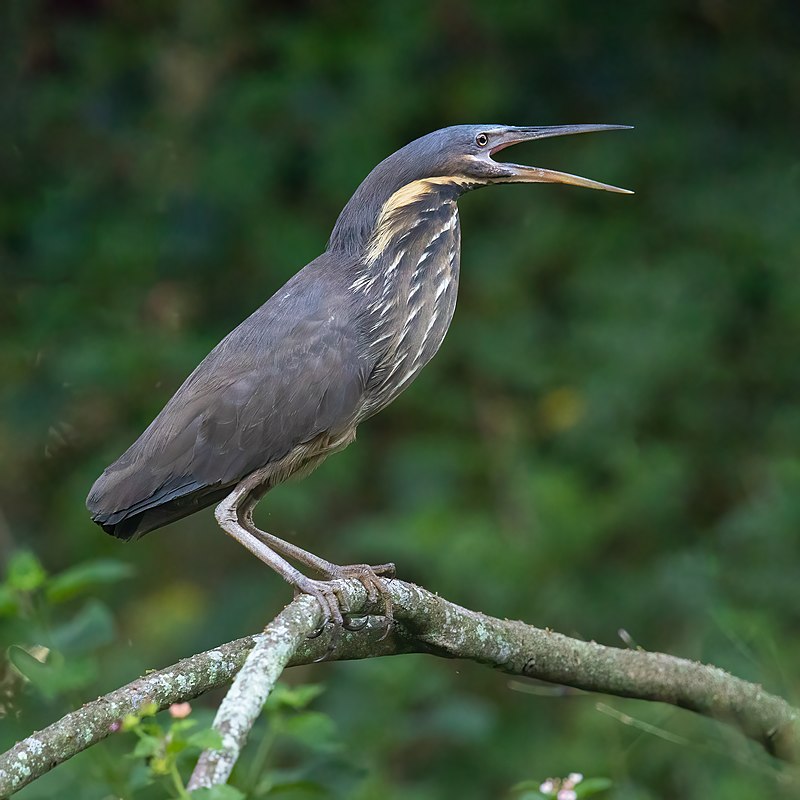
The Black Bittern is a large species of bird found in tropical Asia, stretching from Pakistan to China and Indonesia. It measures 58 cm (23 inches) long which makes it the largest bittern within its genus Ixobrychus.
The bird has black feathers on its back with white stripes running down either side, dark brown upperparts, and yellow-brown underparts.
Its bill is short and thick while its legs are greenish-yellow in color. They mainly reside where they breed but some northern birds migrate for shorter distances during winter seasons.
These birds feed upon fish, frogs, and insects as well as small reptiles among other things making them omnivorous predators of their environment.
Scientific classification:
| Kingdom | Animalia |
| Phylum | Chordata |
| Class | Aves |
| Order | Pelecaniformes |
| Family | Ardeidae |
| Genus | Ixobrychus |
| Species | I. flavicollis |
Also Featured In: Birds of Karnataka, Common Birds of Chhattisgarh
47. Pinnated Bittern
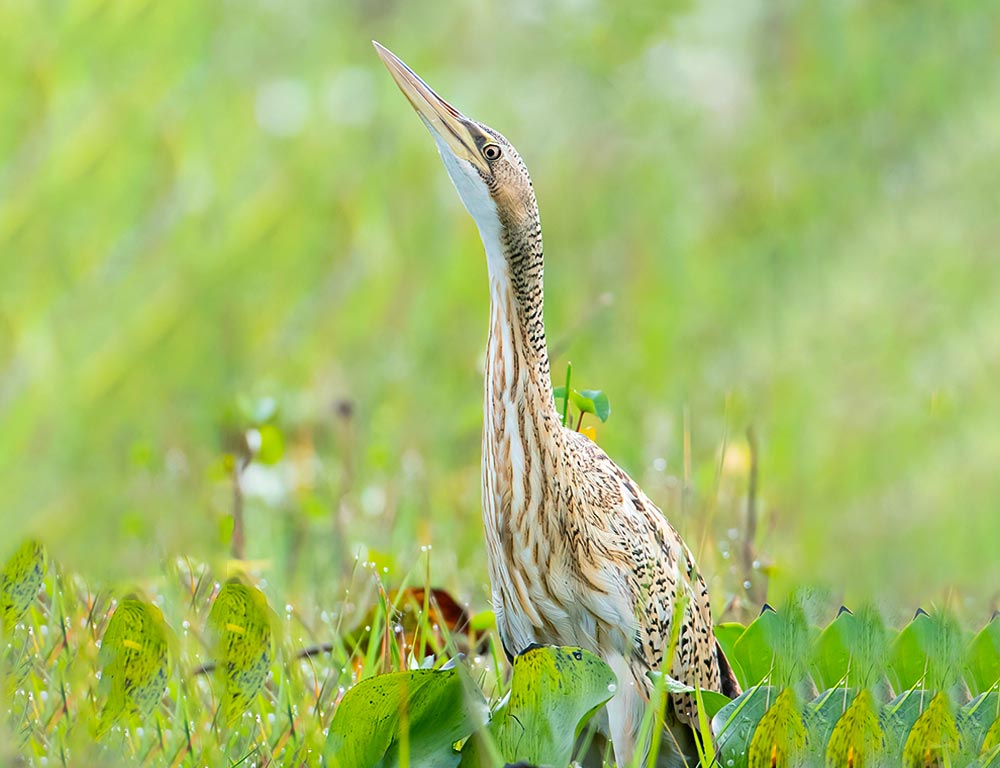
The Pinnated Bittern is a large member of the heron family, found in tropical New World regions. It’s mostly buffy-brown and cryptically patterned with an elusive nature that makes it rarely seen.
Its habitat consists of shallow wetlands including marshes, swamps, and lake shores where it feeds on amphibians, reptiles, and insects such as dragonflies.
The species can become quite vocal during breeding season which includes various low growls emitted from its hiding spot amongst reeds or tall grasses to attract mates or warn intruders.
Despite being widespread, there remains much unknown about this secretive bird due to difficulty studying them in their natural environment making conservation efforts challenging yet essential for the future survival of this unique species.
Scientific classification:
| Kingdom | Animalia |
| Phylum | Chordata |
| Class | Aves |
| Order | Pelecaniformes |
| Family | Ardeidae |
| Genus | Botaurus |
| Species | B. pinnatus |
48. Malagasy Pond Heron
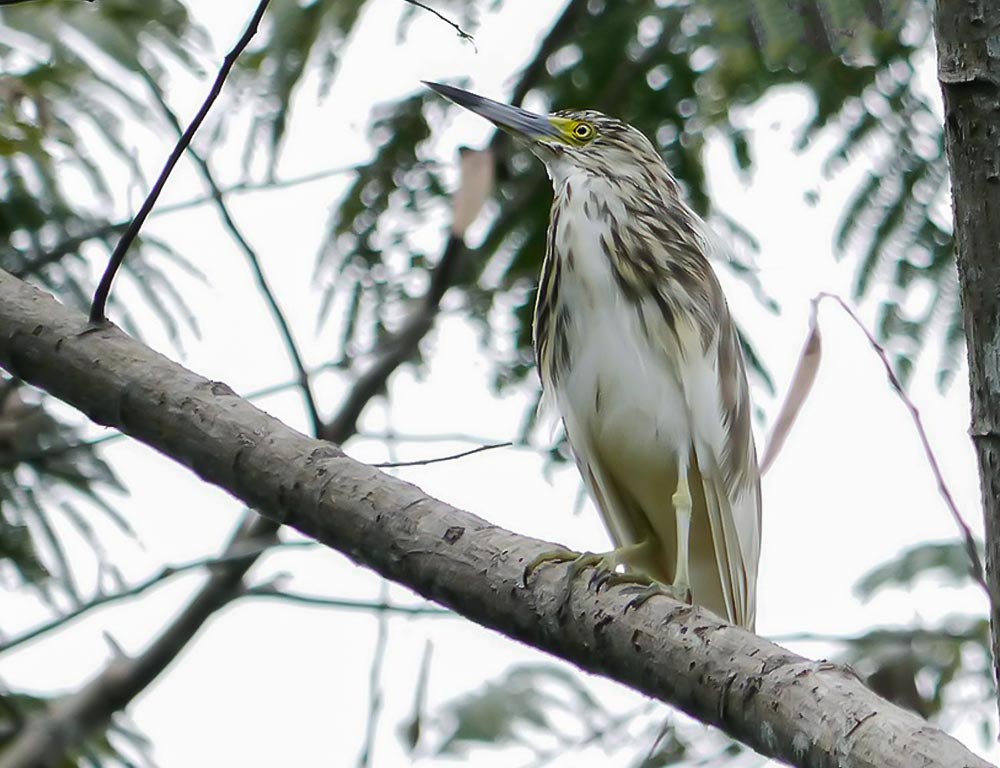
The Malagasy pond heron is an endangered species of bird that primarily breeds in Madagascar, Réunion, and the Seychelles. During non-breeding season it migrates to eastern mainland Africa.
Its population is estimated to be between 1,300 and 4,000 adults only due to several factors such as habitat destruction caused by human activities like agriculture, deforestation, and hunting for food or feathers.
The birds are medium-sized with grayish-brown upper parts while their underparts are white.
They have long yellow legs which enable them to wade through shallow waters easily when they hunt fish or other small aquatic creatures for food.
Conservation efforts need to be taken quickly if we want this beautiful species to become extinct.
Scientific classification:
| Kingdom | Animalia |
| Phylum | Chordata |
| Class | Aves |
| Order | Pelecaniformes |
| Family | Ardeidae |
| Genus | Ardeola |
| Species | A. idae |
49. Rufous-Bellied Heron
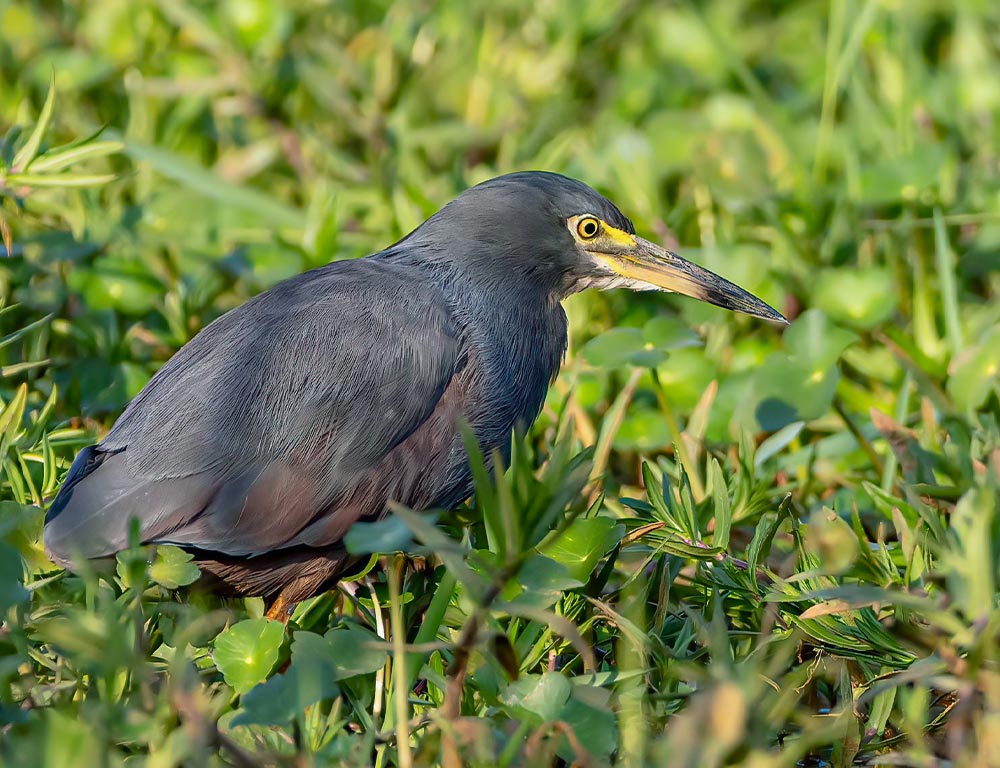
The Rufous-bellied Heron is a small dark species of heron with a distinct coloring. Its head, back and breast are all dark grey in contrast to its rufous belly, wings, and tail which create an eye-catching appearance when it flies due to the bright yellow legs and feet that stand out against the darkness.
Juveniles have paler coloration than adults. It lives near freshwater lakes or rivers as well as marshes where it feeds on fish or amphibians by standing still for long periods waiting for prey to come within reach before striking quickly with their beak.
This bird can often be seen early in the morning flying low over wetlands looking for food sources under cover of darkness.
Scientific classification:
| Kingdom | Animalia |
| Phylum | Chordata |
| Class | Aves |
| Order | Pelecaniformes |
| Family | Ardeidae |
| Genus | Ardeola |
| Species | A. rufiventris |
50. Dimorphic Egret
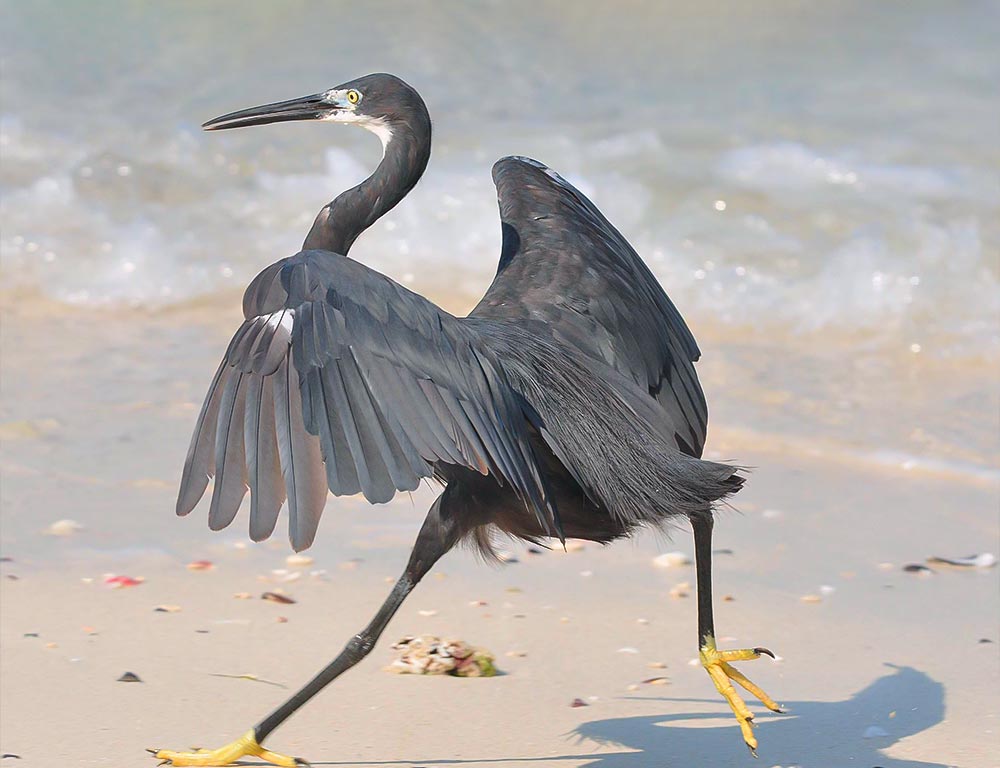
The Dimorphic Egret is an elegant species of heron found in the Comoros, Kenya, Madagascar, Mayotte, Seychelles, and Tanzania.
It has a unique distinguishing feature; two different colour morphs – one white with black spots or streaks and the other entirely yellow-brown.
It can sometimes be seen on rooftops where it feeds on insects such as beetles and locusts. The Dimorphic Egret often nests in colonies near water sources like streams or rivers but will also nest close to mangroves when available.
During breeding season they are known to perform courtship displays which involve them fanning their wings while calling out loudly.
This beautiful bird’s future may be threatened by human activities including habitat destruction due to urbanization and increasing levels of pollution caused by agricultural runoff entering its wetland habitats so conservation efforts must continue for this fascinating creature.
Scientific classification:
| Kingdom | Animalia |
| Phylum | Chordata |
| Class | Aves |
| Order | Pelecaniformes |
| Family | Ardeidae |
| Genus | Egretta |
| Species | E. dimorpha |
51. White-Backed Night Heron
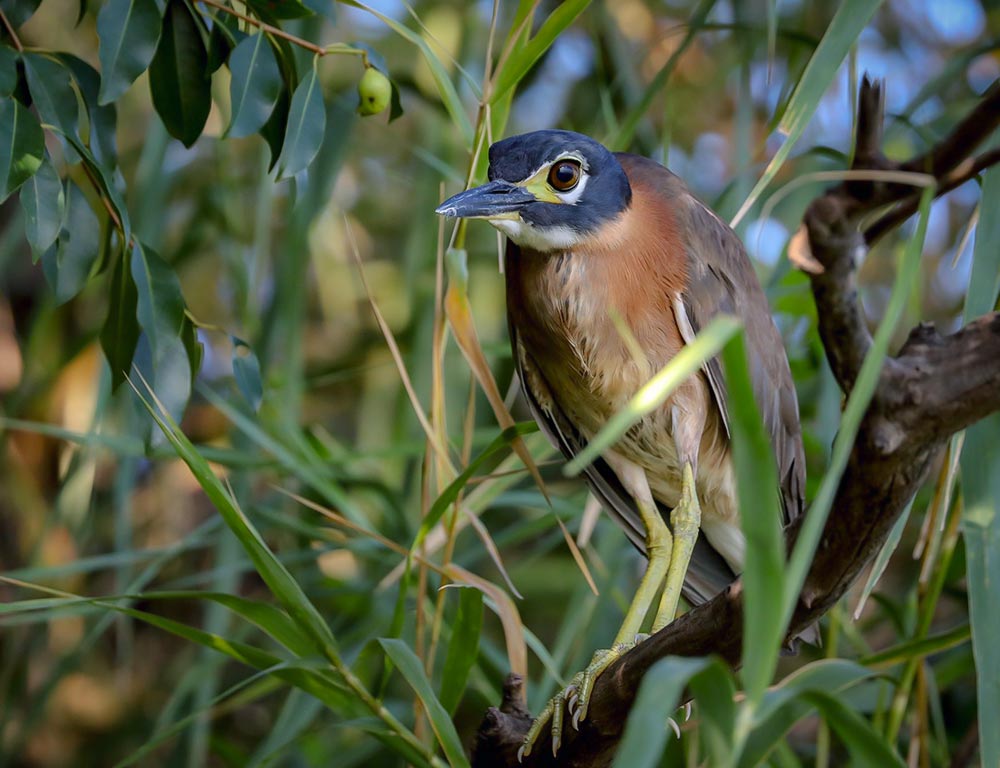
The white-backed night heron is a species of medium-sized heron found in sub-Saharan Africa.
It was first described by German naturalist Johann Wagler as Ardea leuconotus back in 1827 and today, the International Ornithological Committee has classified it into the genus Gorsachius.
This bird is predominantly greyish brown all over with its distinctive namesake – a whitish gray patch on its upper back near the neck area extending to the wingspan when opened up during flight.
Its body length ranges from 60–70 cm and weight between 400–600 g which makes it smaller than other members of their family (Ardeidae).
They generally feed on aquatic insects, small fishes, frogs, and crustaceans; making use of their long bill to probe water bodies for food items.
Overall they are secretive birds that tend to stay hidden while hunting but can be easily identified due to a unique combination of features including short tails and rounded head shape combined with loud calls heard at dusk or dawn hours.
Scientific classification:
| Kingdom | Animalia |
| Phylum | Chordata |
| Class | Aves |
| Order | Pelecaniformes |
| Family | Ardeidae |
| Genus | Gorsachius |
| Species | G. leuconotus |
Conclusion
The world is home to a diverse array of 51 heron species, each with its unique characteristics and adaptations.
These elegant and often strikingly beautiful birds are found on nearly every continent, from the wetlands of the Americas to the rivers and lakes of Europe, Asia, Africa, and Australia.
Herons play crucial roles in their respective ecosystems, serving as top predators and helping to regulate fish populations.
Their graceful and patient hunting techniques have captivated the fascination of bird enthusiasts and nature lovers worldwide.
Preserving their habitats and protecting these magnificent birds is essential for maintaining the biodiversity and balance of our planet’s ecosystems.